Danielle Ellison's Blog, page 3
November 18, 2025
Upcycling Clothes: Creativity, Sustainability and Fashion Statements
Upcycling clothes is a vibrant movement that combines creativity with sustainability, allowing individuals to transform old garments into fashionable new pieces. This innovative practice not only reduces waste in the fashion industry but also empowers consumers to express their unique style while promoting eco-conscious habits. By exploring various techniques and sources of inspiration, anyone can embark on a journey to create stunning, personalized fashion statements from what might otherwise be discarded.

Upcycling clothes promotes sustainability in fashion by transforming old garments into new, stylish pieces, thereby reducing waste and conserving resources. This creative approach not only minimizes the environmental impact of the fashion industry but also encourages consumers to adopt more eco-conscious habits.
Reduces textile wasteUpcycling significantly reduces textile waste by repurposing items that would otherwise end up in landfills. The fashion industry is responsible for a large portion of global waste, with millions of tons of textiles discarded each year. By creatively reusing these materials, individuals can help divert waste from landfills and contribute to a more sustainable future.
For example, turning an old pair of jeans into a stylish tote bag not only gives the fabric a new life but also prevents it from contributing to the growing textile waste problem. This practice encourages a shift in mindset towards valuing existing materials rather than constantly seeking new ones.
Conserves resourcesUpcycling clothes conserves valuable resources by reducing the demand for new materials. The production of textiles often requires significant amounts of water, energy, and raw materials, contributing to environmental degradation. By upcycling, consumers can minimize the need for these resources and lessen the overall environmental footprint of their wardrobe.
For instance, creating a new garment from old fabric eliminates the need for new production processes, which can be resource-intensive. This not only saves water and energy but also reduces pollution associated with manufacturing new textiles.
Encourages eco-friendly practicesUpcycling encourages eco-friendly practices by promoting creativity and resourcefulness in fashion. It inspires individuals to think critically about their consumption habits and consider the environmental impact of their choices. By engaging in upcycling, consumers can develop a deeper appreciation for sustainability and its importance in the fashion industry.
Additionally, upcycling can foster community engagement through workshops and events where people share skills and ideas. This collaborative approach not only strengthens social bonds but also amplifies the message of sustainability, encouraging more people to adopt eco-friendly practices in their daily lives.
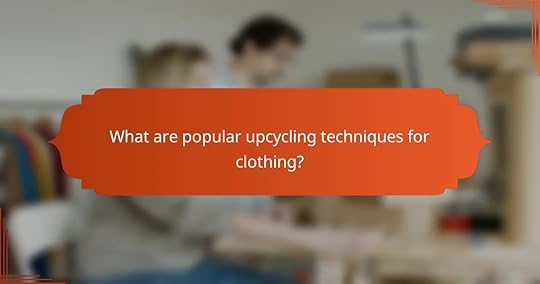
Popular upcycling techniques for clothing include methods that creatively repurpose old garments into new, stylish pieces. These techniques not only promote sustainability but also allow individuals to express their unique fashion sense.
Patchwork and embroideryPatchwork and embroidery are effective ways to breathe new life into worn-out clothing. By sewing together different fabric pieces, you can create a unique design that showcases your creativity. Embroidery can enhance these designs, adding intricate details and personal touches.
When considering patchwork, choose fabrics that complement each other in color and texture. This technique works well on jackets, bags, and even jeans. For embroidery, simple stitches can transform a plain garment into a statement piece.
Transforming old jeans into bagsTransforming old jeans into bags is a practical and stylish upcycling technique. This process involves cutting and sewing the jeans into various bag shapes, such as totes or crossbody styles. The durability of denim makes it an ideal material for bags.
To start, select a pair of jeans that you no longer wear. Cut the legs to your desired length and sew the openings to create a bag base. You can add pockets, straps, or embellishments to personalize your creation. This method not only reduces waste but also results in a functional accessory.
Reworking t-shirts into new stylesReworking t-shirts into new styles allows for endless creativity and customization. Techniques include cutting, tying, or adding fabric to create unique silhouettes. This approach is perfect for transforming oversized or outdated tees into trendy pieces.
For example, you can cut a t-shirt into a crop top or create a stylish off-the-shoulder look. Adding lace or other fabric can enhance the design further. This method is particularly appealing for those looking to refresh their wardrobe without spending money on new clothes.

Inspiration for upcycling projects can be found in various creative spaces, from social media to local workshops. Exploring these resources can ignite your imagination and help you transform old garments into fashionable statements.
Social media platforms like InstagramInstagram is a vibrant hub for upcycling inspiration, featuring countless creators who share their unique projects. By following hashtags such as #upcycle, #refashion, and #sustainablefashion, you can discover innovative ideas and techniques.
Engaging with the community through comments and direct messages can also provide valuable tips and encouragement. Consider saving posts that resonate with you to create a personal inspiration board.
DIY blogs and YouTube channelsMany DIY blogs and YouTube channels focus specifically on upcycling clothing, offering step-by-step guides and tutorials. These platforms often include detailed instructions, material lists, and videos that make the process accessible for beginners.
Look for channels that align with your style preferences and skill level. Bookmarking your favorite blogs can create a go-to resource for future projects, ensuring you have a wealth of ideas at your fingertips.
Upcycling workshops in urban areasParticipating in upcycling workshops can provide hands-on experience and direct guidance from experts. Many urban areas host classes that cater to various skill levels, allowing you to learn new techniques while meeting like-minded individuals.
Check local community centers, craft stores, or online platforms for upcoming workshops. These events often supply materials and tools, making it easier to dive into your projects without needing to invest heavily upfront.

The best materials for upcycling clothes include natural fibers, denim, and vintage fabrics. These materials not only offer durability and versatility but also allow for creative expression while promoting sustainability.
Natural fibers like cotton and linenNatural fibers such as cotton and linen are excellent choices for upcycling due to their breathability and ease of manipulation. They can be easily dyed, sewn, or embroidered, making them ideal for various projects.
When selecting natural fibers, consider using pre-loved garments or remnants to minimize waste. Look for fabrics that are in good condition, as they will yield the best results in your upcycling endeavors.
Denim from old jeansDenim is a popular material for upcycling, particularly from old jeans. Its durability allows for a wide range of projects, from bags to jackets, and it can be easily combined with other fabrics.
When working with denim, consider the weight and color of the fabric. Heavier denim is suitable for structured items, while lighter denim can be used for more delicate applications. Don’t hesitate to mix different shades for a unique look.
Vintage fabrics from thrift storesVintage fabrics sourced from thrift stores are a treasure trove for upcycling enthusiasts. These materials often come in unique patterns and textures that can add character to any project.
When shopping for vintage fabrics, inspect them for wear and tear. Look for pieces that can be repurposed without compromising their integrity. A good rule of thumb is to choose fabrics that are at least 50% intact for successful upcycling.
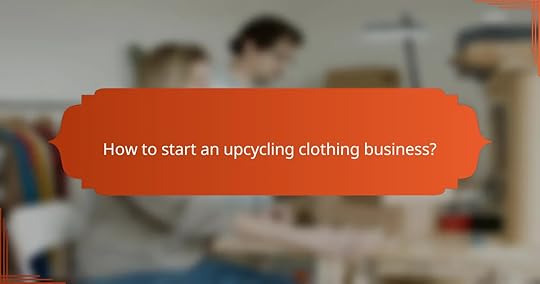
Starting an upcycling clothing business involves creatively transforming used garments into fashionable items while promoting sustainability. Focus on your design skills, sourcing materials, and understanding your audience to build a successful venture.
Identify your target marketUnderstanding your target market is crucial for your upcycling clothing business. Determine who is most likely to buy your products, such as eco-conscious consumers, fashion enthusiasts, or budget shoppers looking for unique pieces.
Consider demographics like age, gender, and lifestyle. For instance, younger consumers may prefer trendy, bold designs, while older customers might appreciate classic styles. Conduct surveys or social media polls to gather insights about potential customers��� preferences.
Source sustainable materialsSourcing sustainable materials is key to maintaining the eco-friendly ethos of your upcycling clothing business. Look for second-hand clothing, fabric remnants, or even thrift store finds that can be transformed into new designs.
Consider local sources to reduce your carbon footprint. Check community groups or online marketplaces for fabric donations or sales. Establish relationships with local thrift shops or textile recycling centers to ensure a steady supply of materials.
Set up an online store on platforms like EtsyCreating an online store on platforms like Etsy allows you to reach a wider audience for your upcycled clothing. Start by setting up an account, then create appealing listings with high-quality images and detailed descriptions of your items.
Utilize SEO strategies by including relevant keywords in your product titles and descriptions to improve visibility. Engage with customers through social media and encourage reviews to build credibility. Consider offering promotions or discounts to attract initial buyers and grow your customer base.
November 17, 2025
Eco-Friendly Fashion: Plus-Size Options, Style Tips and Comfort
Eco-friendly fashion is making strides in the plus-size market, offering stylish and sustainable options that cater to diverse tastes. By choosing materials like organic cotton and Tencel, you can enjoy comfort and style while minimizing your environmental footprint. Embrace versatile pieces that flatter your shape and allow for creative outfit combinations, ensuring you look good while being kind to the planet.
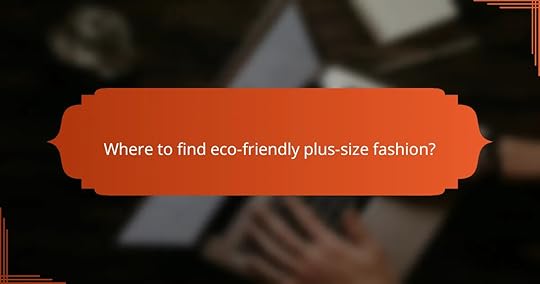
Eco-friendly plus-size fashion can be found through various channels, including online retailers, local boutiques, and specialty brands. These options cater to diverse styles while prioritizing sustainable practices.
Online retailers like ASOS and ModClothOnline retailers such as ASOS and ModCloth offer a wide range of eco-friendly plus-size clothing. They feature collections made from sustainable materials and often highlight their commitment to ethical manufacturing processes.
When shopping online, check for filters that allow you to search specifically for eco-friendly options. Look for labels that indicate organic fabrics, recycled materials, or fair-trade practices to ensure your choices align with sustainability goals.
Local boutiques in major citiesMany major cities have local boutiques that specialize in eco-friendly plus-size fashion. These shops often curate collections from local designers who focus on sustainable practices and unique styles.
Visiting local boutiques allows you to try on clothing and receive personalized styling advice. Additionally, supporting local businesses contributes to the community and reduces the carbon footprint associated with shipping.
Specialty brands like Reformation and Eileen FisherSpecialty brands such as Reformation and Eileen Fisher are known for their commitment to sustainability and inclusivity in plus-size fashion. These brands often use eco-friendly materials and transparent supply chains.
Consider exploring their collections for versatile pieces that can be mixed and matched. Both brands frequently offer timeless styles that not only fit well but also promote a sustainable wardrobe.
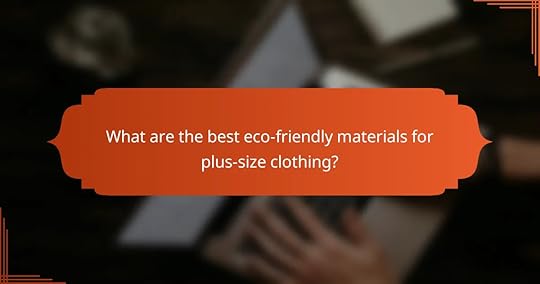
The best eco-friendly materials for plus-size clothing include organic cotton, Tencel (lyocell), and recycled polyester. These fabrics not only reduce environmental impact but also provide comfort and style for plus-size individuals.
Organic cottonOrganic cotton is grown without synthetic pesticides or fertilizers, making it a sustainable choice for plus-size clothing. This material is soft, breathable, and hypoallergenic, which is ideal for sensitive skin.
When shopping for organic cotton garments, look for certifications such as GOTS (Global Organic Textile Standard) to ensure the product meets environmental and social criteria. Brands often offer a range of styles, from casual wear to more formal options.
Tencel (lyocell)Tencel, or lyocell, is made from sustainably sourced wood pulp, primarily from eucalyptus trees. This fabric is known for its silky feel, moisture-wicking properties, and biodegradability, making it a great eco-friendly option for plus-size clothing.
Consider Tencel garments for their drape and comfort, especially in warmer climates. They often come in various styles, providing versatility for different occasions. Look for brands that highlight their sustainable practices in sourcing and production.
Recycled polyesterRecycled polyester is created from post-consumer plastic waste, such as bottles, reducing landfill impact and conserving resources. This material is durable, lightweight, and often moisture-resistant, making it suitable for activewear and casual clothing.
When choosing recycled polyester clothing, check for certifications like the Global Recycled Standard (GRS) to ensure the fabric’s sustainability. Many brands are now offering stylish plus-size options, allowing for both fashion and eco-consciousness.
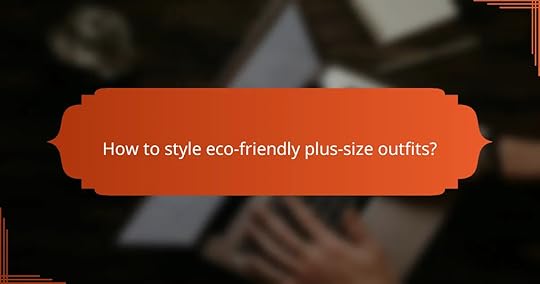
Styling eco-friendly plus-size outfits involves selecting sustainable materials and flattering cuts that enhance your shape while being kind to the planet. Focus on versatile pieces that can be mixed and matched, allowing for creativity and comfort in your wardrobe.
Layering techniquesLayering is essential for creating stylish plus-size outfits that are both functional and fashionable. Start with a fitted base layer, such as a sustainable cotton or bamboo top, and add a flowy cardigan or an oversized jacket for dimension. Aim for a balance between fitted and loose pieces to enhance your silhouette.
Consider using lightweight fabrics that breathe well, especially in warmer climates. For colder months, opt for thicker, eco-friendly materials like recycled wool or organic cotton. Remember to play with lengths; longer layers can elongate your figure, while shorter ones can highlight your waist.
Accessorizing with sustainable jewelrySustainable jewelry can elevate your eco-friendly plus-size outfits while making a statement. Look for pieces made from recycled materials, ethically sourced gemstones, or artisan-crafted items that support local communities. These accessories not only enhance your outfit but also reflect your commitment to sustainability.
When accessorizing, consider the scale of your jewelry in relation to your outfit. Larger, bold pieces can complement simpler outfits, while delicate items work well with more intricate designs. Aim for a cohesive look by choosing colors and materials that harmonize with your clothing palette.
Mixing textures for visual interestMixing textures is a powerful way to add depth to your eco-friendly plus-size outfits. Combine soft fabrics like organic cotton with sturdier materials such as linen or hemp to create a visually appealing contrast. This technique can draw attention to your best features while keeping the overall look dynamic.
Experiment with different textures by pairing a chunky knit sweater with a sleek, satin skirt or combining a textured top with smooth trousers. Be mindful of the color palette; sticking to a cohesive color scheme can help unify the various textures and create a polished appearance.

Eco-friendly plus-size fashion prioritizes comfort through thoughtful design and material choices. Key features include breathable fabrics, stretchy materials for ease of movement, and inclusive sizing that enhances fit.
Breathable fabricsBreathable fabrics are essential for comfort, especially in warmer climates. Materials like organic cotton, linen, and Tencel allow air circulation, reducing sweat and discomfort. Look for garments labeled as moisture-wicking to help keep you dry.
When shopping, consider the weight of the fabric; lighter materials are typically more breathable. Additionally, check for certifications like GOTS (Global Organic Textile Standard) to ensure the sustainability of the fabric.
Stretchy materials for movementStretchy materials, such as spandex blends, provide flexibility and comfort, allowing for a full range of motion. This is particularly important for plus-size fashion, where fit and ease of movement can significantly impact wearability.
Opt for clothing with at least 5-10% spandex or elastane for a comfortable stretch. This ensures that the garment retains its shape while accommodating body movements, making it ideal for both casual and active wear.
Inclusive sizing for better fitInclusive sizing is crucial in eco-friendly plus-size fashion, as it ensures that a diverse range of body types can find well-fitting options. Brands that offer extended size ranges often consider body shape variations, leading to more flattering fits.
When choosing clothing, pay attention to size charts and customer reviews for insights on fit. Some brands may use unique sizing systems, so understanding their specific measurements can help you select the best size for your body type.
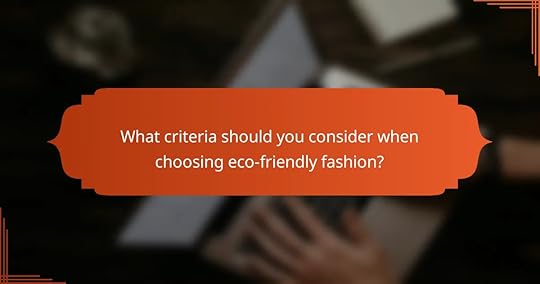
When selecting eco-friendly fashion, consider the brand’s sustainability practices, material sourcing, and certifications. These factors help ensure that your clothing choices support environmentally responsible production and ethical labor practices.
Brand sustainability practicesEvaluate how brands approach sustainability by looking for transparency in their operations. Check if they have clear policies on waste reduction, energy use, and carbon emissions. Brands that engage in circular fashion, such as recycling or upcycling materials, often demonstrate a stronger commitment to sustainability.
Additionally, consider whether the brand supports fair labor practices. Certifications like Fair Trade or membership in organizations that promote ethical labor can indicate a brand’s dedication to both environmental and social responsibility.
Material sourcing and certificationsFocus on the materials used in the clothing, as this greatly impacts its environmental footprint. Look for natural fibers like organic cotton, linen, or Tencel, which are generally more sustainable than conventional materials. Synthetic fabrics made from recycled plastics can also be a good option, reducing waste in landfills.
Certifications such as Global Organic Textile Standard (GOTS) or OEKO-TEX can help you identify truly eco-friendly materials. These labels ensure that textiles meet rigorous environmental and safety standards, providing peace of mind about your purchases.
Sustainable Clothing: Identifying Ethical Brands
In today’s fashion landscape, identifying ethical clothing brands is essential for consumers seeking to make responsible choices. This involves scrutinizing their sustainability practices, labor rights, and environmental impact, while also looking for transparency and relevant certifications. By supporting these brands, individuals can help foster a more sustainable and equitable fashion industry.

Identifying ethical clothing brands involves examining their practices regarding sustainability, labor rights, and environmental impact. Look for brands that prioritize transparency, hold relevant certifications, and maintain a positive reputation among consumers.
Transparency in supply chainsTransparency in supply chains means that a brand openly shares information about where and how its products are made. Ethical brands often provide details on their suppliers, manufacturing processes, and labor conditions. Check if the brand publishes a list of factories or engages in initiatives that promote supply chain accountability.
To assess transparency, look for brands that disclose their sourcing practices and are willing to answer questions about their production methods. Brands that are open about their supply chains are more likely to adhere to ethical standards.
Certifications and labelsCertifications and labels can help identify ethical clothing brands by indicating compliance with specific environmental and social standards. Look for well-known certifications such as Fair Trade, GOTS (Global Organic Textile Standard), or OEKO-TEX, which signify adherence to ethical practices.
When evaluating certifications, consider the criteria behind them. For instance, Fair Trade focuses on fair wages and safe working conditions, while GOTS emphasizes organic materials and environmentally friendly processes. Brands displaying these labels often commit to higher ethical standards.
Brand reputation and reviewsBrand reputation and consumer reviews are critical in identifying ethical clothing brands. Research online reviews and ratings to gauge customer satisfaction and ethical practices. Platforms like social media and review sites can provide insights into a brand’s commitment to sustainability and labor rights.
Additionally, consider the brand’s history and any controversies it may have faced. Brands with a consistent track record of ethical behavior and positive customer feedback are more likely to be trustworthy. Look for testimonials that highlight the brand’s commitment to ethical practices.
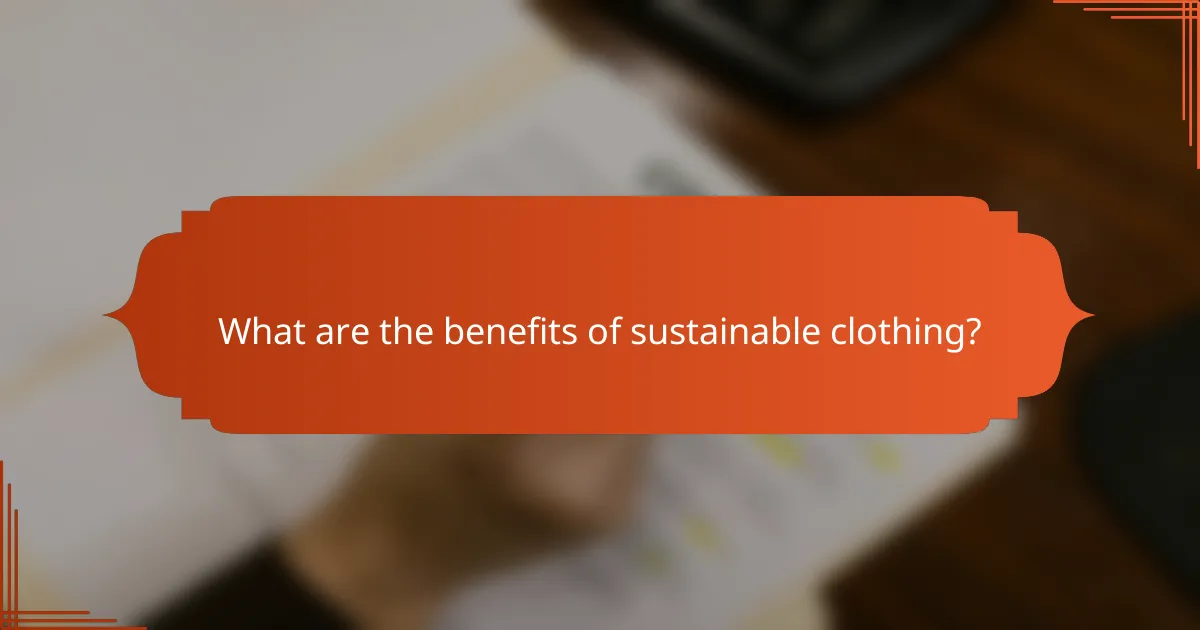
Sustainable clothing offers numerous advantages, including reduced environmental impact, support for fair labor practices, and potential long-term cost savings. By choosing ethical brands, consumers can contribute to a more responsible fashion industry.
Environmental impact reductionSustainable clothing significantly lowers the environmental footprint of the fashion industry. This includes reduced water usage, lower greenhouse gas emissions, and minimized waste through practices like recycling and upcycling materials.
For example, organic cotton uses about 90% less water compared to conventional cotton. Additionally, brands that prioritize eco-friendly materials, such as Tencel or recycled polyester, help decrease the reliance on virgin resources.
Support for fair labor practicesChoosing sustainable clothing often means supporting brands that adhere to fair labor practices. These companies typically ensure safe working conditions, fair wages, and respect for workers’ rights throughout their supply chains.
Look for certifications like Fair Trade or GOTS (Global Organic Textile Standard) when shopping. These labels indicate that the brand meets strict criteria for ethical labor practices, promoting social responsibility in the fashion industry.
Long-term cost savingsInvesting in sustainable clothing can lead to long-term cost savings. While the initial purchase price may be higher, these garments are often made with higher-quality materials that last longer, reducing the need for frequent replacements.
Consider that a well-made sustainable garment can last several years, while fast fashion items may need to be replaced within a season. This durability translates to fewer purchases over time, ultimately saving money in the long run.

Several brands are at the forefront of sustainable fashion, prioritizing ethical practices and eco-friendly materials. Patagonia, Eileen Fisher, and Everlane are notable examples, each with unique approaches to sustainability and transparency in their production processes.
PatagoniaPatagonia is renowned for its commitment to environmental responsibility and ethical manufacturing. The brand uses recycled materials in many of its products and actively supports various environmental initiatives through its 1% for the Planet program.
When shopping at Patagonia, look for their Fair Trade Certified items, which ensure fair wages and safe working conditions for workers. Their Worn Wear program also encourages customers to repair and recycle gear, promoting a circular economy.
Eileen FisherEileen Fisher emphasizes simplicity and sustainability in its clothing lines, focusing on organic and renewable materials. The brand has a strong commitment to reducing waste through its Renew program, which takes back used garments for resale or recycling.
Consider Eileen Fisher for timeless pieces that are designed to last. Their transparency about sourcing and production practices allows consumers to make informed choices, aligning with ethical fashion values.
EverlaneEverlane is known for its “Radical Transparency” approach, providing detailed information about the costs and factories behind its products. The brand prioritizes ethical labor practices and uses sustainable materials in its collections.
When choosing Everlane, pay attention to their commitment to minimizing environmental impact, such as using recycled materials and reducing water usage. Their pricing reflects the true cost of production, allowing consumers to support fair wages and practices.

When selecting sustainable clothing, focus on material sourcing, production practices, and end-of-life options. These criteria help you identify brands that prioritize environmental responsibility and ethical labor practices.
Material sourcingMaterial sourcing refers to how and where the raw materials for clothing are obtained. Look for brands that use organic, recycled, or sustainably harvested materials, such as organic cotton, Tencel, or recycled polyester. These materials typically have a lower environmental impact compared to conventional options.
Additionally, consider certifications like Global Organic Textile Standard (GOTS) or OEKO-TEX, which indicate adherence to strict environmental and social criteria. Brands that prioritize local sourcing can also reduce transportation emissions, enhancing sustainability.
Production practicesProduction practices encompass the methods and conditions under which clothing is manufactured. Ethical brands often ensure fair wages, safe working conditions, and reasonable hours for their workers. Look for transparency in the supply chain, as brands that disclose their factories and labor practices are more likely to adhere to ethical standards.
Certifications such as Fair Trade or WRAP (Worldwide Responsible Accredited Production) can also signal responsible production practices. Avoid brands that rely on fast fashion models, as these often exploit labor and environmental resources.
End-of-life optionsEnd-of-life options refer to how clothing can be disposed of or recycled after use. Sustainable brands often provide take-back programs or recycling initiatives, allowing consumers to return items for proper disposal or repurposing. This reduces landfill waste and promotes a circular economy.
When evaluating brands, check if they offer guidance on caring for and recycling their products. Brands that encourage repair and reuse can significantly extend the life of clothing, minimizing environmental impact.
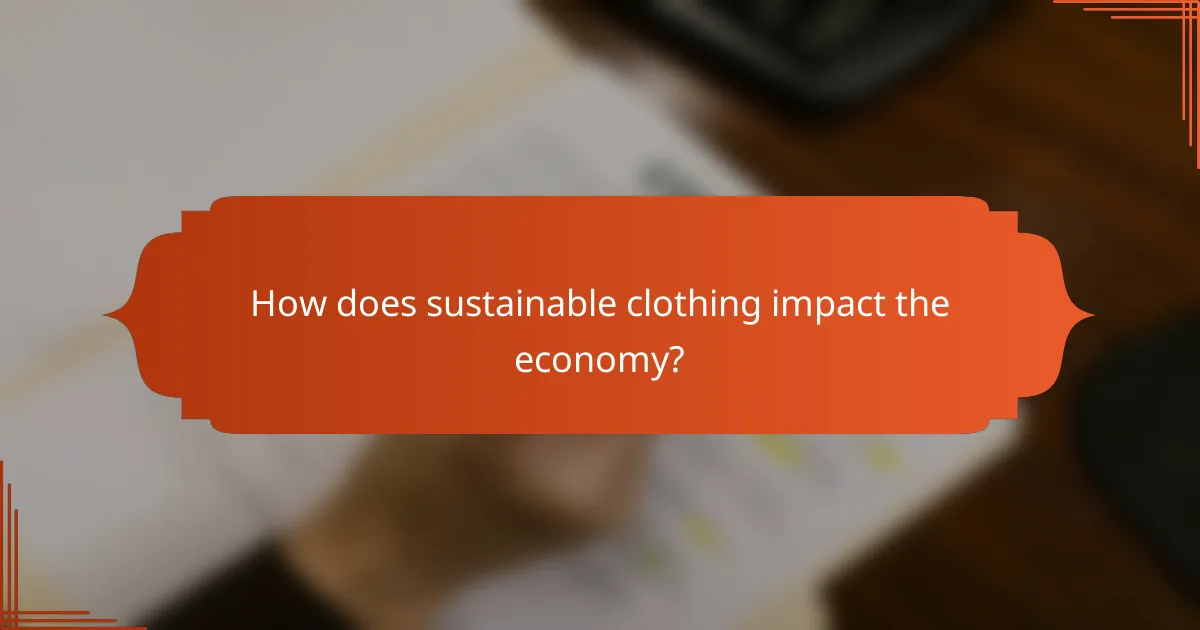
Sustainable clothing positively impacts the economy by promoting ethical practices that lead to job creation and support for local businesses. This approach encourages a shift towards environmentally friendly production methods, which can stimulate economic growth while addressing social and environmental issues.
Job creation in ethical sectorsThe sustainable clothing industry generates jobs in various sectors, including manufacturing, retail, and logistics. Ethical brands often prioritize fair labor practices, which can lead to better working conditions and wages for employees.
For instance, companies that focus on organic materials or recycled fabrics typically require skilled workers for production processes. This demand can create opportunities in local communities, particularly in regions where traditional garment manufacturing has declined.
Support for local businessesSustainable clothing brands frequently collaborate with local artisans and suppliers, fostering economic growth within their communities. By sourcing materials locally, these companies reduce transportation costs and support regional economies.
Additionally, ethical brands often engage in fair trade practices, ensuring that local producers receive fair compensation. This not only strengthens local economies but also promotes sustainable agricultural practices, benefiting both the environment and community livelihoods.
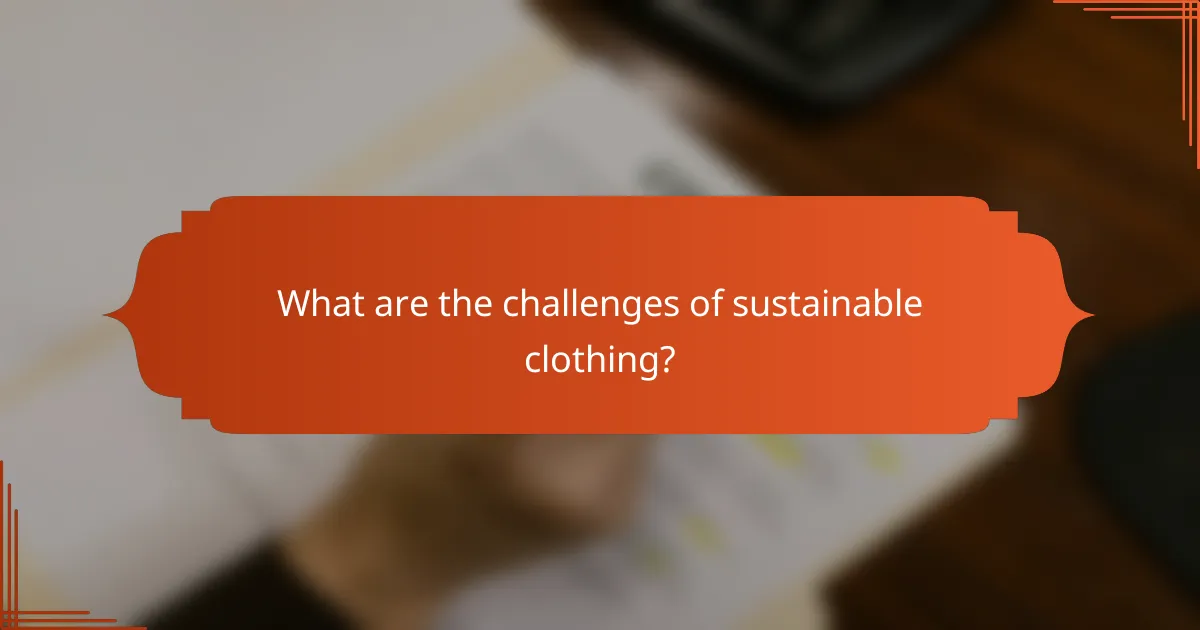
Sustainable clothing faces several challenges, including higher production costs, limited availability, and consumer awareness. These factors can affect both the pricing of ethical brands and the accessibility of sustainable options in the market.
Higher price pointsOne significant challenge of sustainable clothing is its higher price points compared to conventional garments. Ethical brands often use premium materials and fair labor practices, which can lead to costs that are substantially higher, sometimes by 20-50% or more.
Consumers should consider that while the initial investment may be greater, sustainable clothing often lasts longer and has a lower environmental impact. This can make it a more economical choice over time, as it reduces the need for frequent replacements.
When shopping for sustainable options, look for sales or second-hand items to mitigate costs. Many ethical brands also offer loyalty programs or discounts for first-time buyers, making sustainable choices more accessible.
Cultural Influences on Sustainable Fashion: Trends, Values and Global Impact
The intersection of cultural influences and sustainable fashion reveals a dynamic landscape where values such as environmental stewardship and social responsibility shape consumer behavior and design practices. As global trends shift towards eco-friendly materials and ethical production, consumers increasingly favor brands that align with their sustainability values. This growing awareness prompts a significant transformation in the fashion industry, compelling brands to adopt practices that reflect a commitment to sustainability and local heritage.

Sustainable fashion in Europe is significantly shaped by cultural values that prioritize environmental stewardship, social responsibility, and local heritage. These values drive consumer preferences and influence designers to adopt practices that reflect a commitment to sustainability.
Emphasis on local craftsmanshipIn many European countries, there is a strong emphasis on local craftsmanship, which fosters a connection between consumers and the products they purchase. This focus encourages the use of skilled artisans who create high-quality, durable items, reducing the need for fast fashion alternatives.
Brands that highlight local craftsmanship often tell stories about their artisans, enhancing the perceived value of their products. This approach not only supports local economies but also promotes a sense of community and cultural identity.
Integration of traditional textilesThe integration of traditional textiles into sustainable fashion is a key trend in Europe, where many designers draw inspiration from their cultural heritage. These textiles often feature unique patterns and techniques that reflect local history and craftsmanship.
Using traditional textiles can reduce environmental impact by minimizing reliance on synthetic materials and promoting the use of natural fibers. Consumers are increasingly drawn to these pieces, as they offer a blend of sustainability and cultural significance, making them more meaningful purchases.
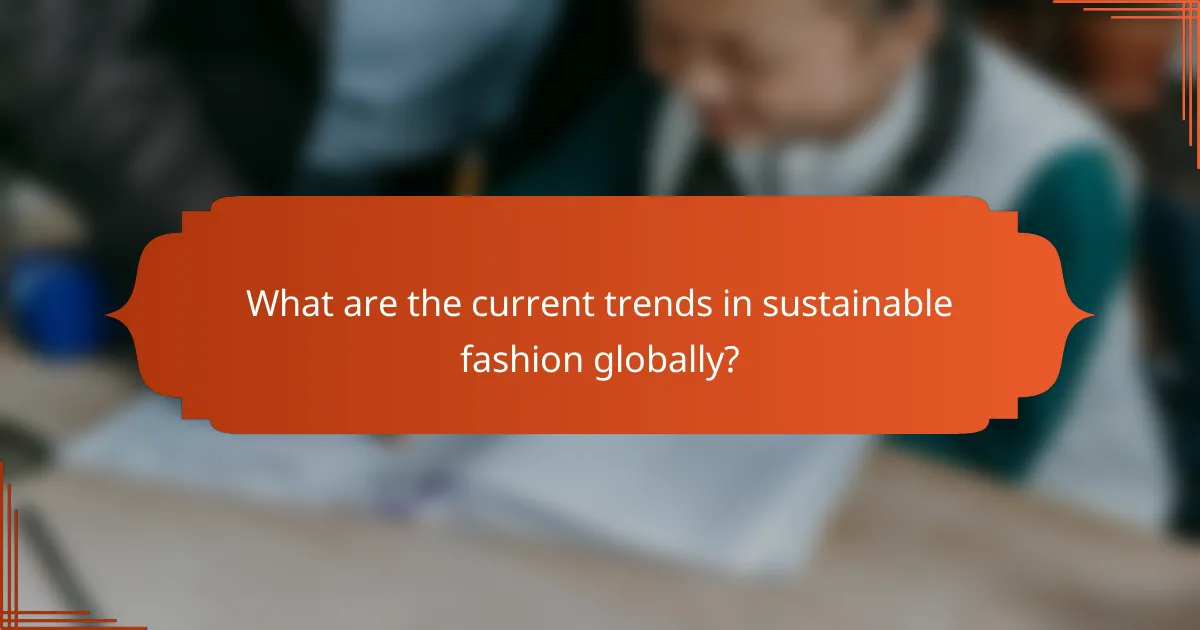
Current trends in sustainable fashion globally include a significant shift towards eco-friendly practices, with brands increasingly adopting sustainable materials and ethical production methods. Consumers are becoming more conscious of their purchasing decisions, favoring brands that align with their values of sustainability and social responsibility.
Rise of upcycled materialsThe rise of upcycled materials is a key trend in sustainable fashion, where discarded textiles and products are transformed into new garments. This practice not only reduces waste but also minimizes the need for new resources, making it an environmentally friendly option.
Brands are creatively using upcycled materials to produce unique pieces, often highlighting the story behind the materials used. For example, some companies incorporate vintage fabrics or repurpose unsold inventory, appealing to eco-conscious consumers who value originality.
Popularity of rental fashion servicesRental fashion services have gained popularity as a sustainable alternative to fast fashion, allowing consumers to wear high-quality garments without the commitment of purchase. This model promotes a circular economy by extending the lifecycle of clothing and reducing overall consumption.
Many platforms offer a wide range of options, from everyday wear to luxury items, making it accessible for various budgets. Users can rent outfits for special occasions or try new styles without the environmental impact of buying new clothes. However, it’s essential to consider the rental terms and potential fees to ensure a cost-effective experience.
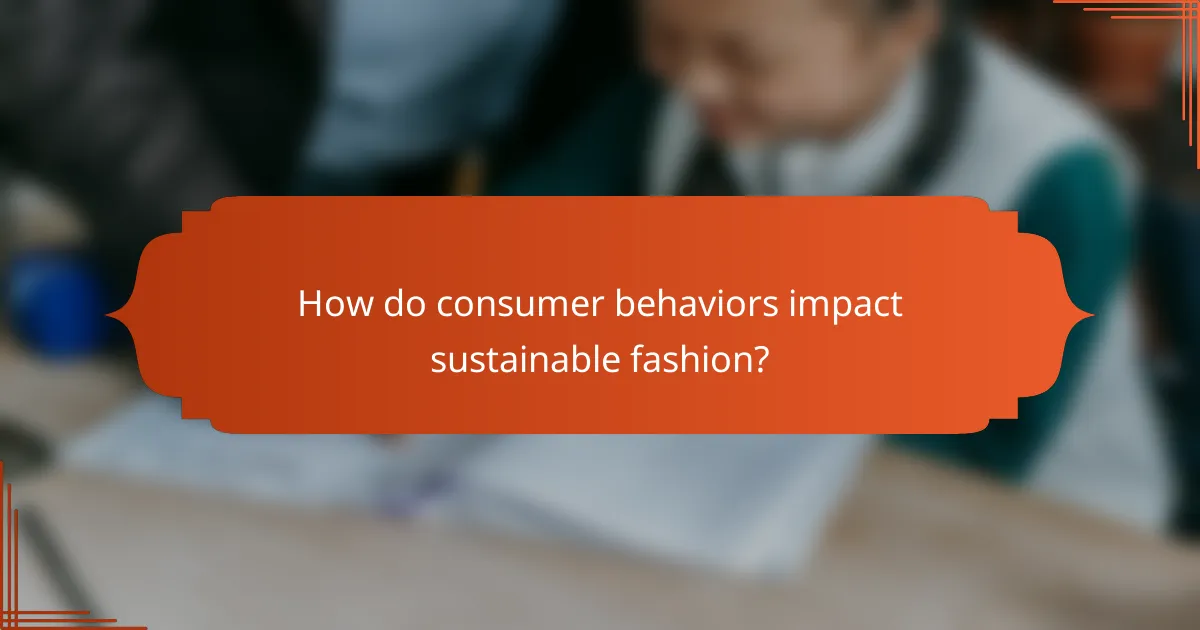
Consumer behaviors significantly influence sustainable fashion by driving demand for eco-friendly products and ethical practices. As consumers become more conscious of their purchasing decisions, brands are compelled to adopt sustainable practices to meet these expectations.
Increased demand for transparencyConsumers are increasingly seeking transparency from fashion brands regarding their supply chains and production processes. This demand for clarity encourages brands to disclose information about sourcing materials, labor conditions, and environmental impact.
Brands that provide detailed insights into their operations often gain a competitive edge, as consumers are more likely to support companies that align with their values. For instance, brands that share their sustainability certifications or ethical sourcing practices can enhance consumer trust and loyalty.
Shift towards ethical purchasingThe shift towards ethical purchasing reflects a growing preference for products that are produced in a socially and environmentally responsible manner. Consumers are now more inclined to choose brands that prioritize fair labor practices, sustainable materials, and minimal environmental impact.
To make ethical purchasing decisions, consumers can look for certifications such as Fair Trade or Global Organic Textile Standard (GOTS). Additionally, they can support local artisans or brands that emphasize sustainable practices, ensuring their purchases contribute positively to the community and environment.

Fashion brands play a crucial role in promoting sustainability by adopting eco-friendly practices and collaborating with environmental organizations. Their influence can drive consumer behavior and set industry standards, making sustainability a core value in the fashion sector.
Adoption of eco-friendly practicesFashion brands can adopt eco-friendly practices by using sustainable materials, reducing waste, and implementing ethical production processes. For instance, brands may choose organic cotton or recycled fabrics, which significantly lower the environmental impact compared to conventional materials.
Additionally, brands can minimize waste through practices like upcycling and offering repair services. Implementing a circular economy model, where products are designed for longevity and recyclability, is becoming increasingly common among forward-thinking companies.
Collaboration with environmental organizationsCollaborating with environmental organizations allows fashion brands to enhance their sustainability efforts and credibility. These partnerships can lead to initiatives such as tree planting campaigns or ocean clean-up projects, which not only benefit the environment but also resonate with eco-conscious consumers.
Brands should seek partnerships that align with their values and mission. For example, a brand focused on reducing plastic waste might collaborate with organizations dedicated to marine conservation. Such alliances can amplify their impact and foster a positive brand image.
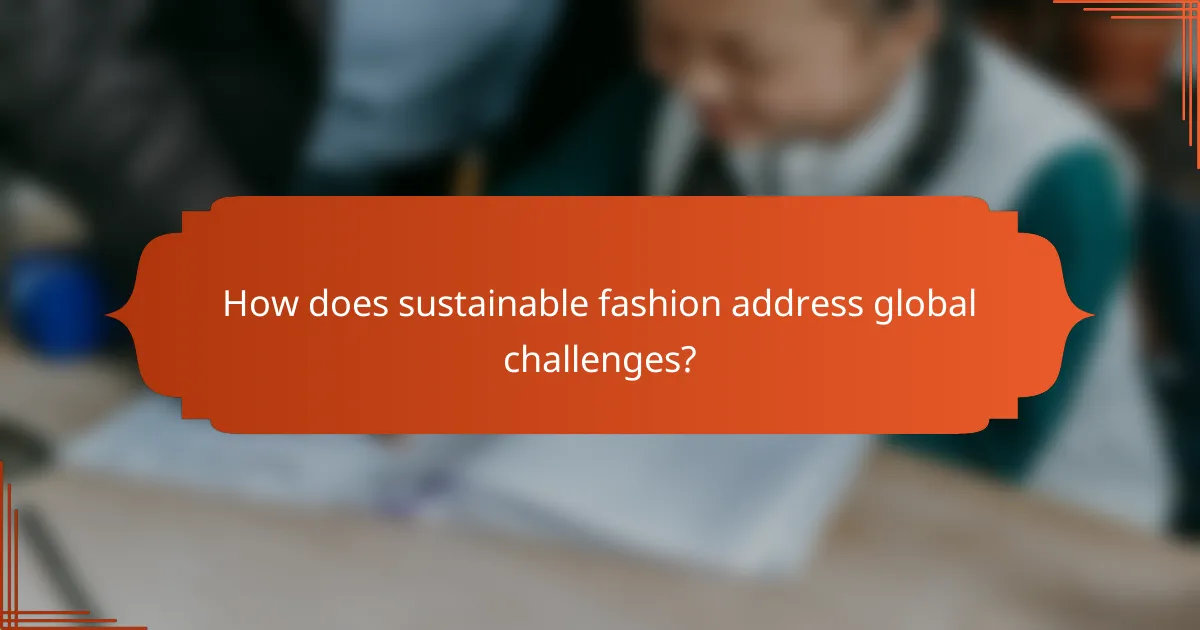
Sustainable fashion tackles global challenges by promoting eco-friendly practices that reduce environmental impact and enhance social equity. This approach not only minimizes waste and resource consumption but also encourages ethical labor practices across the supply chain.
Reduction of textile wasteThe reduction of textile waste is a crucial aspect of sustainable fashion, as the industry is known for generating significant amounts of discarded materials. Brands are increasingly adopting circular economy principles, which focus on reusing and recycling fabrics to extend their lifecycle.
For example, many companies now offer take-back programs where customers can return old garments for recycling or repurposing. This practice not only diverts waste from landfills but also fosters a culture of sustainability among consumers.
Mitigation of climate change effectsSustainable fashion plays a vital role in mitigating climate change effects by reducing greenhouse gas emissions associated with textile production. This includes using organic materials, implementing energy-efficient manufacturing processes, and minimizing water usage.
Brands that prioritize sustainability often seek certifications, such as Global Organic Textile Standard (GOTS), which ensures environmentally friendly practices. By choosing sustainable materials and methods, the fashion industry can significantly lower its carbon footprint, contributing to broader climate goals.

Sustainable fashion practices are guided by various frameworks that emphasize environmental responsibility, social equity, and economic viability. These frameworks help brands and consumers understand the impact of their choices and promote a more sustainable industry.
Global Fashion Agenda’s Circular Fashion SystemThe Global Fashion Agenda’s Circular Fashion System promotes a shift from the traditional linear model of fashion to a circular approach. This system encourages brands to design products with the entire lifecycle in mind, focusing on material reuse, recycling, and reducing waste.
Key principles include designing for longevity, using sustainable materials, and implementing take-back schemes. For example, brands can offer discounts for returned items, incentivizing customers to recycle their clothing instead of discarding it.
UN Sustainable Development GoalsThe UN Sustainable Development Goals (SDGs) provide a global framework for addressing various social and environmental challenges, including those in the fashion industry. Goal 12 specifically targets responsible consumption and production, urging brands to adopt sustainable practices.
Fashion companies can align with the SDGs by minimizing waste, ensuring fair labor practices, and using eco-friendly materials. For instance, brands can commit to sourcing organic cotton or reducing water usage in production, contributing to broader sustainability efforts.
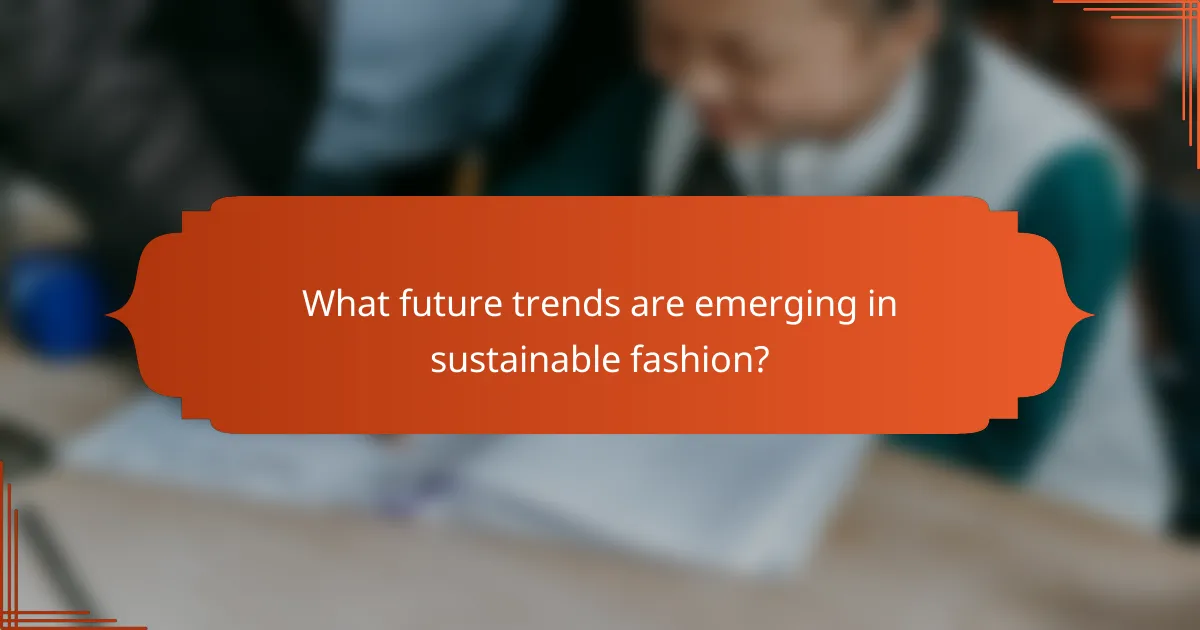
Future trends in sustainable fashion are increasingly focused on circularity, transparency, and technological innovation. Brands are adopting practices that minimize waste and promote ethical production, responding to consumer demand for environmentally friendly and socially responsible products.
Increased Use of Sustainable MaterialsThe shift towards sustainable materials is a key trend in the future of fashion. Brands are exploring organic cotton, recycled polyester, and innovative materials like mushroom leather and bio-fabricated textiles. This not only reduces environmental impact but also appeals to eco-conscious consumers.
For example, many companies are now using recycled ocean plastics in their collections, which helps reduce marine pollution while creating stylish products. Expect to see more brands committing to using at least 50% sustainable materials in their lines over the next few years.
Transparency and Ethical ProductionTransparency in supply chains is becoming essential as consumers demand to know the origins of their clothing. Brands are increasingly sharing information about their sourcing, production processes, and labor practices. This trend fosters trust and accountability, encouraging companies to adopt fair labor practices.
For instance, some brands now provide detailed information on their websites about the factories they work with, including certifications and worker conditions. This level of transparency is likely to become a standard expectation in the industry.
Technological InnovationsTechnological advancements are shaping the future of sustainable fashion by enabling more efficient production methods and reducing waste. Innovations such as 3D printing and digital fashion design allow for on-demand production, minimizing overproduction and excess inventory.
Additionally, blockchain technology is being utilized to enhance traceability in the supply chain, ensuring that materials are sourced ethically. As these technologies become more accessible, expect a broader adoption among brands committed to sustainability.
Consumer Engagement and EducationEngaging consumers in the sustainability conversation is crucial for the future of fashion. Brands are increasingly focusing on educating their customers about the environmental impact of their purchases and promoting sustainable practices.
Workshops, social media campaigns, and collaborations with influencers are effective ways to raise awareness. As consumers become more informed, they are likely to prioritize sustainable choices, driving demand for responsible fashion.
November 16, 2025
Renting Clothes: Sustainability, Variety and Cost-Effectiveness
Renting clothes is an innovative solution that promotes sustainability by decreasing the demand for new garments, thereby reducing environmental impact. This approach not only allows consumers to enjoy a wide variety of styles for different occasions but also offers significant cost savings, making high-quality fashion accessible without the financial burden of ownership.
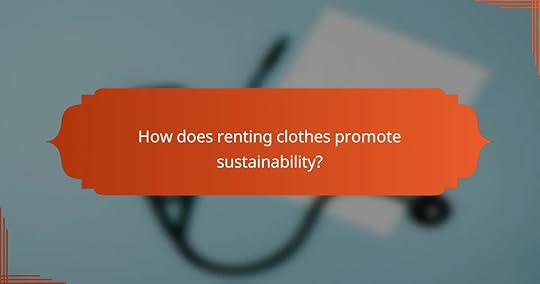
Renting clothes significantly enhances sustainability by reducing the demand for new garments, which in turn lessens the environmental impact of clothing production. This practice helps conserve resources and minimizes waste, contributing to a more sustainable fashion industry.
Reduces textile wasteRenting clothes directly reduces textile waste by extending the lifecycle of garments. When consumers rent instead of buy, fewer clothes end up in landfills, which is crucial given that millions of tons of textile waste are generated annually. By sharing clothing, we can collectively decrease the volume of discarded items.
Additionally, rental services often focus on high-quality, durable pieces that are designed to last longer, further minimizing waste. This approach encourages consumers to think critically about their clothing choices and promotes a more sustainable mindset.
Encourages circular fashionRenting clothes promotes circular fashion by facilitating the reuse and recycling of garments. This model encourages brands to design clothes with longevity in mind, knowing that their products will be returned and rented multiple times. As a result, the fashion industry can transition from a linear model of production to a circular one.
Moreover, many rental services actively participate in recycling initiatives, ensuring that items that can no longer be rented are repurposed or recycled responsibly. This creates a closed-loop system that benefits both consumers and the environment.
Minimizes carbon footprintRenting clothes helps minimize the carbon footprint associated with clothing production and transportation. By sharing garments, the overall demand for new clothing decreases, which in turn reduces the energy and resources needed for manufacturing. This is particularly important in regions where the fashion industry is a significant contributor to greenhouse gas emissions.
For instance, renting can cut down on the carbon emissions linked to shipping and distribution, as fewer items are produced and transported. Consumers can further enhance their sustainability efforts by choosing local rental services, which reduces transportation-related emissions.

Renting clothes offers significant cost-effective benefits, primarily by reducing upfront expenses and providing access to premium brands without the hefty price tag. This approach allows consumers to enjoy a diverse wardrobe while minimizing financial commitment.
Lower upfront costsOne of the main advantages of renting clothes is the lower upfront costs compared to purchasing. Renting typically requires a fraction of the retail price, making it easier to try out various styles without a large financial investment. For instance, a designer dress that retails for several hundred dollars might be available for rent at a cost of just a few tens of dollars.
This affordability allows individuals to refresh their wardrobe frequently, which is particularly beneficial for special occasions or seasonal events. It���s essential to compare rental prices across platforms to find the best deals and avoid overspending.
Access to high-end brandsRenting clothes provides access to high-end brands that may otherwise be unaffordable. Many rental services offer items from luxury designers, allowing consumers to wear exclusive pieces for a fraction of the retail price. This access can elevate personal style without the financial burden of purchasing expensive garments.
For example, a high-fashion gown from a renowned designer can be rented for a special event, giving the wearer a taste of luxury without the commitment. This option is particularly appealing for fashion enthusiasts who want to experiment with premium labels.
Flexible subscription modelsMany clothing rental services offer flexible subscription models that cater to different needs and budgets. Subscriptions can range from monthly plans to pay-per-rental options, allowing users to choose what works best for their lifestyle. This flexibility means that individuals can adjust their spending based on their wardrobe needs at any given time.
For instance, a monthly subscription might allow for several rentals per month, which is ideal for those who frequently attend events. However, casual users might prefer a pay-per-use model to avoid ongoing costs. Understanding the terms and conditions of each subscription is crucial to maximize value and avoid unexpected charges.

Renting clothing offers a diverse selection that caters to various occasions and personal styles. From formal attire to everyday wear, rental services provide options that can suit different needs without the commitment of purchasing.
Formal wear optionsFormal wear rentals typically include items such as tuxedos, evening gowns, and cocktail dresses. These pieces are ideal for weddings, galas, and other special events where dressing to impress is essential. Many rental services offer a range of sizes and styles, ensuring a good fit for most body types.
When renting formal wear, consider the rental duration and any additional fees for cleaning or damage. It’s advisable to book well in advance, especially during peak wedding seasons, to secure your desired outfit.
Casual and everyday wearCasual clothing rentals encompass a variety of items, including tops, bottoms, and outerwear suitable for daily use. This option allows individuals to refresh their wardrobe without the financial burden of purchasing new clothes. Popular items include jeans, t-shirts, and lightweight jackets.
When selecting casual wear, look for rental services that offer flexible return policies and a wide range of styles. This flexibility can help you try different looks without long-term commitment, making it easier to adapt to changing trends.
Seasonal collectionsSeasonal clothing rentals provide access to outfits tailored for specific times of the year, such as summer dresses or winter coats. This service is particularly useful for those who want to enjoy the latest seasonal trends without investing in pieces that may only be worn once or twice.
Be mindful of the timing when renting seasonal items, as availability may vary. It’s beneficial to plan ahead for holidays or events, ensuring you have the right attire when you need it. Additionally, consider the care instructions for seasonal fabrics, as some may require special handling.

Several platforms in the US provide clothing rental services, catering to various styles and budgets. These services allow users to rent outfits for special occasions or everyday wear, promoting sustainability and variety in fashion choices.
Rent the RunwayRent the Runway is a popular clothing rental service that offers a wide selection of designer dresses and accessories. Users can choose to rent items for a specific period, typically ranging from four to eight days, or opt for a subscription model that allows for multiple rentals each month.
When using Rent the Runway, consider the size and fit, as the platform provides detailed sizing guides and customer reviews. This can help avoid common pitfalls like ordering the wrong size. Additionally, the service often includes insurance for minor damages, providing peace of mind during your rental period.
Le ToteLe Tote operates on a subscription basis, allowing users to rent a box of clothing and accessories each month. Subscribers can wear the items as long as they like, and then return them for a new selection. This model encourages variety and experimentation with different styles.
One key aspect of Le Tote is its emphasis on personal styling. Users fill out a style profile, which helps the service curate selections tailored to individual tastes. Be mindful of the return process, as timely returns are necessary to avoid extra charges. The flexibility of keeping items longer can be appealing, but it���s essential to track what you have rented.
HURR CollectiveHURR Collective focuses on peer-to-peer clothing rentals, allowing individuals to rent their own wardrobes to others. This platform promotes sustainability by encouraging users to share their fashion items rather than letting them sit unused. It���s a great option for those looking to access unique pieces while supporting a circular fashion economy.
When using HURR, consider the condition and style of items before renting, as quality can vary significantly. Communication with the item owner is crucial for understanding any specific care instructions or return policies. This platform is ideal for fashion enthusiasts who want to explore diverse styles without the commitment of purchase.
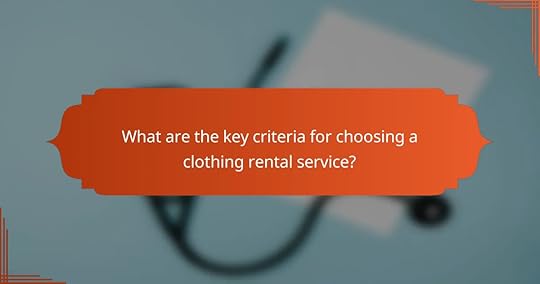
When selecting a clothing rental service, consider pricing, quality of items, and shipping policies. These factors will significantly impact your overall experience and satisfaction with the service.
Pricing and subscription plansPricing structures for clothing rental services can vary widely. Some offer pay-per-use options, while others provide subscription plans that charge a monthly fee for a set number of items.
Evaluate what fits your budget and lifestyle. For instance, a subscription might cost around $50 to $150 per month, depending on the number of items and brands included. Look for services that offer flexible plans to avoid long-term commitments.
Quality and brand selectionThe quality of clothing and the variety of brands available are crucial. High-quality items not only enhance your wardrobe but also ensure durability during rental periods.
Research the brands offered by each service. Some focus on designer labels, while others may provide a mix of high-street and luxury options. Reading reviews can help gauge the quality and fit of the clothing.
Shipping and return policiesShipping and return policies can greatly affect your rental experience. Look for services that offer free shipping both ways, as this can save you money and hassle.
Check the return timeframe and whether you need to clean the items before sending them back. Many services allow you to return items within a few days, while others may provide longer rental periods. Understanding these policies helps avoid extra charges.
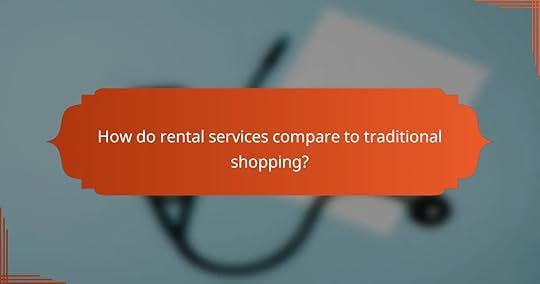
Rental services offer a flexible and often more sustainable alternative to traditional shopping by allowing consumers to access a variety of clothing without the commitment of purchase. This approach can lead to significant cost savings and reduced environmental impact, making it an attractive option for many shoppers.
Cost savings analysisRenting clothes can lead to substantial cost savings compared to buying new items. For instance, renting a designer dress for an event may cost a fraction of the retail price, which can often be several hundred dollars. Over time, if you frequently rent instead of buy, these savings can accumulate significantly.
Additionally, rental services often include maintenance and cleaning in their fees, which can further reduce the overall costs associated with clothing ownership. This means you save not only on the purchase price but also on upkeep expenses.
Environmental impact comparisonThe environmental impact of rental services is generally lower than that of traditional shopping. By renting clothes, you contribute to a circular economy that promotes reuse and reduces waste. This model helps decrease the demand for new clothing production, which is resource-intensive and contributes to pollution.
Moreover, many rental companies focus on sustainable practices, such as using eco-friendly materials and minimizing packaging waste. This commitment can make renting a more environmentally responsible choice for fashion-conscious consumers.
Convenience and flexibilityRental services offer significant convenience and flexibility, allowing consumers to easily access a wide range of styles without long-term commitment. Many platforms provide user-friendly websites and apps that make browsing and selecting items quick and straightforward.
Additionally, rental services often allow for short-term use, making it easy to try out different looks for various occasions without cluttering your wardrobe. This flexibility is particularly beneficial for those who enjoy changing their style frequently or need outfits for specific events.
Vegan Leather Alternatives: Materials, Benefits and Ethical Considerations
Vegan leather alternatives provide a sustainable and ethical choice for consumers looking to reduce their environmental impact while avoiding animal products. Materials such as pleather, pineapple leather, and mushroom leather each come with unique benefits, making them appealing for various styles and uses. By opting for these alternatives, individuals can support animal welfare and contribute to a more eco-friendly fashion industry.
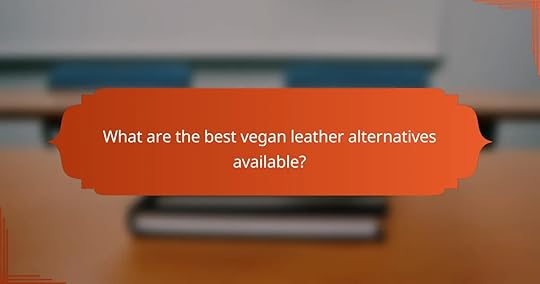
The best vegan leather alternatives include materials like pleather, pineapple leather, mushroom leather, cork leather, and recycled plastic leather. Each of these options offers unique benefits and considerations for consumers seeking sustainable and ethical choices.
Pleather (Polyurethane)Pleather, or polyurethane leather, is a synthetic material designed to mimic the look and feel of real leather. It is often more affordable than traditional leather and can be produced in various textures and colors.
However, pleather is made from petroleum-based products, which raises concerns about environmental impact. When choosing pleather, look for options that are free from harmful chemicals and produced with eco-friendly processes.
Pineapple leather (Pi��atex)Pineapple leather, known as Pi��atex, is made from the fibers of pineapple leaves, a byproduct of the fruit industry. This innovative material is biodegradable and offers a unique texture, making it a popular choice for fashion accessories and apparel.
While Pi��atex is sustainable, it may not be as durable as traditional leather. It’s essential to consider the intended use and care requirements when selecting products made from pineapple leather.
Mushroom leather (Mylo)Mushroom leather, branded as Mylo, is crafted from mycelium, the root structure of mushrooms. This material is biodegradable and can be produced with minimal environmental impact, making it an appealing option for eco-conscious consumers.
Mylo offers a soft texture and can be dyed in various colors. However, availability may be limited, and consumers should check for brands that prioritize sustainable sourcing and production practices.
Cork leatherCork leather is made from the bark of cork oak trees, which can be harvested without harming the tree. This renewable resource is lightweight, water-resistant, and has a unique appearance, making it suitable for various products.
While cork leather is durable, it may not have the same luxurious feel as traditional leather. It’s a great option for those looking for a sustainable alternative with a distinct aesthetic.
Recycled plastic leatherRecycled plastic leather is created from post-consumer plastic waste, such as bottles and bags, which are processed into a leather-like material. This option helps reduce plastic pollution while providing a viable alternative to traditional leather.
When selecting recycled plastic leather, look for products that emphasize transparency in their sourcing and manufacturing processes. This ensures that the environmental benefits are maximized and that the product is safe for use.

Vegan leather alternatives offer several advantages, including environmental sustainability, improved animal welfare, and a wide variety of styles. These materials often require fewer resources to produce and can reduce the demand for animal-based products.
Environmental sustainabilityVegan leather alternatives are generally more environmentally friendly than traditional leather. Many options, such as those made from recycled plastics or plant-based materials, have a lower carbon footprint and use less water during production.
For instance, materials like cork or pineapple leaves (Pi��atex) are renewable and biodegradable, making them appealing choices for eco-conscious consumers. Choosing these alternatives can contribute to reducing waste and pollution.
Animal welfareUsing vegan leather alternatives directly supports animal welfare by eliminating the need for animal skins. This shift helps reduce the suffering associated with the livestock industry, where animals are often subjected to harsh conditions.
By opting for synthetic or plant-based materials, consumers can align their purchasing decisions with ethical considerations, promoting a more compassionate approach to fashion and accessories.
Durability and maintenanceMany vegan leather alternatives are designed to be durable and easy to maintain. For example, high-quality synthetic leathers can be resistant to wear and tear, making them suitable for everyday use.
Maintenance typically involves simple cleaning with a damp cloth, unlike traditional leather, which may require special conditioners and treatments. This ease of care can be a significant advantage for busy individuals.
Variety of stylesThe market for vegan leather alternatives has expanded significantly, offering a wide range of styles, colors, and textures. Consumers can find everything from sleek handbags to stylish jackets, all made from innovative materials.
This variety allows individuals to express their personal style without compromising their values. With options available at various price points, there is likely a vegan leather product to suit every taste and budget.
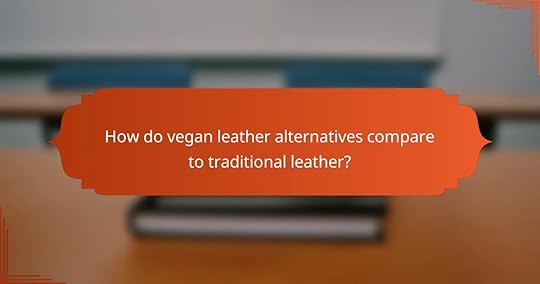
Vegan leather alternatives generally offer a more sustainable and animal-friendly option compared to traditional leather. While they can vary significantly in terms of cost, durability, and production methods, many consumers find them appealing for ethical and environmental reasons.
Cost comparisonThe cost of vegan leather alternatives can vary widely, often ranging from affordable to premium pricing. For instance, synthetic options like polyurethane (PU) can be less expensive than traditional leather, typically costing between $20 to $100 per yard, while high-quality plant-based leathers may reach similar or higher price points as genuine leather.
When budgeting for vegan leather, consider not only the initial purchase price but also potential long-term savings in maintenance and care. Traditional leather often requires more upkeep, which can add to its overall cost over time.
Longevity and wearVegan leather alternatives typically have varying degrees of durability. While some synthetic options can be quite resilient, they may not match the lifespan of high-quality traditional leather, which can last for years or even decades with proper care. Plant-based leathers, on the other hand, often provide a balance between durability and environmental impact.
It’s essential to assess the intended use of the material. For items subject to heavy wear, such as shoes or bags, choosing a high-quality vegan leather may be crucial to ensure longevity.
Production processesThe production processes for vegan leather alternatives differ significantly from traditional leather, which involves animal hides and often harsh chemical treatments. Many vegan leathers are made from synthetic materials like PVC or PU, while others utilize natural sources such as pineapple leaves, apple peels, or cork.
When evaluating vegan leather options, consider the environmental impact of the production methods. Some materials may be more sustainable than others, so look for certifications or transparency from manufacturers regarding their practices. This can help ensure that your choice aligns with ethical and ecological values.

When choosing vegan leather alternatives, several ethical considerations are crucial. These include labor practices in production and the impact on local ecosystems, both of which can significantly influence the overall sustainability and ethical footprint of these materials.
Labor practices in productionLabor practices in the production of vegan leather can vary widely, affecting workers’ rights and conditions. It’s essential to consider whether the materials are sourced from companies that adhere to fair labor standards, such as paying living wages and ensuring safe working environments.
Look for certifications like Fair Trade or similar labels that indicate ethical labor practices. Avoid brands that do not provide transparency about their supply chains, as this can often signal potential exploitation or unsafe working conditions.
Impact on local ecosystemsThe production of vegan leather can have varying impacts on local ecosystems, depending on the materials used. For instance, some synthetic alternatives may rely on petroleum-based products, which can contribute to pollution and habitat destruction during extraction and manufacturing processes.
On the other hand, plant-based options, such as those made from pineapple leaves or apple peels, can offer more sustainable choices. However, it���s important to assess the agricultural practices involved, as intensive farming can lead to biodiversity loss and soil degradation. Supporting brands that prioritize sustainable sourcing and eco-friendly practices can help mitigate these impacts.
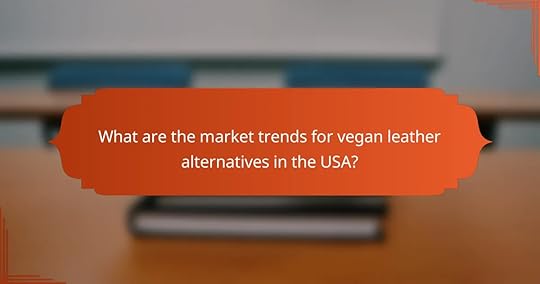
The market for vegan leather alternatives in the USA is rapidly expanding, driven by increasing consumer awareness and demand for sustainable products. This trend reflects a broader shift towards ethical consumption, with many brands adopting plant-based materials to meet customer preferences.
Growing consumer demandConsumer interest in vegan leather alternatives has surged, with many shoppers actively seeking out cruelty-free and environmentally friendly options. Surveys indicate that a significant portion of the population is willing to pay a premium for products made from sustainable materials, often prioritizing brands that align with their values.
This growing demand is influencing major retailers and fashion brands to incorporate vegan leather into their product lines, resulting in a wider variety of styles and options available to consumers. As awareness of the environmental impact of traditional leather production increases, this trend is expected to continue.
Innovations in material technologyAdvancements in material technology are playing a crucial role in the development of vegan leather alternatives. Innovations include the use of materials derived from plants, such as pineapple leaves, apple peels, and mushrooms, which offer durability and aesthetic appeal similar to traditional leather.
These new materials not only reduce reliance on petroleum-based products but also often have a lower environmental footprint. Brands are increasingly experimenting with these technologies to create high-quality, stylish alternatives that appeal to eco-conscious consumers.

Future developments in vegan leather alternatives are likely to focus on innovative materials and broader brand adoption. As technology advances, we can expect more sustainable options that meet consumer demand for ethical and environmentally friendly products.
Emerging sustainable materialsNew materials are continuously being developed to replace traditional leather, with a focus on sustainability. Options like mushroom leather, made from mycelium, and pineapple leather, derived from the fibers of pineapple leaves, are gaining traction. These materials not only reduce reliance on animal products but also minimize environmental impact.
Additionally, lab-grown leather is emerging as a viable alternative, offering the look and feel of animal leather without the ethical concerns. These innovations often utilize less water and energy compared to conventional leather production, making them more eco-friendly choices.
Increased brand adoptionMore brands are recognizing the importance of vegan leather alternatives and are incorporating them into their product lines. This shift is driven by consumer demand for ethical fashion and sustainability. Major fashion labels are now launching collections that feature vegan materials, signaling a significant trend in the industry.
As awareness grows, smaller brands are also entering the market with innovative vegan leather products, often at competitive prices. This increased adoption not only broadens consumer choices but also encourages more sustainable practices across the fashion sector.
October 30, 2025
Hemp Fabric: Sustainability, Breathability and Versatility
Hemp fabric stands out for its sustainability, requiring minimal resources during cultivation and processing while positively impacting the environment. Known for its excellent breathability, it keeps wearers comfortable in various climates by allowing air circulation. Additionally, its versatility makes it suitable for a wide range of applications, from clothing to industrial materials, thanks to its durability and eco-friendly nature.

Hemp fabric is sustainable due to its eco-friendly cultivation and processing methods. It requires minimal resources and contributes positively to the environment throughout its lifecycle.
Biodegradable propertiesHemp fabric is fully biodegradable, meaning it can decompose naturally without harming the environment. When disposed of, it breaks down within a few months, returning nutrients to the soil.
This contrasts sharply with synthetic fabrics, which can take hundreds of years to decompose. Choosing hemp over synthetic options helps reduce landfill waste significantly.
Low water consumptionHemp cultivation requires considerably less water compared to conventional crops like cotton. On average, hemp needs about 50% less water, making it a more sustainable choice in water-scarce regions.
This low water consumption is crucial, especially in areas facing drought or water shortages, as it allows for more efficient use of this vital resource.
Organic farming practicesHemp is often grown using organic farming methods, which avoid synthetic pesticides and fertilizers. This practice not only protects the soil but also promotes biodiversity by supporting various plant and animal life.
Organic hemp farming adheres to strict regulations, ensuring that the fabric produced is free from harmful chemicals, making it safer for consumers and the environment.
Carbon footprint reductionThe cultivation of hemp helps reduce the carbon footprint due to its ability to absorb significant amounts of CO2 from the atmosphere. A hectare of hemp can absorb approximately 15 tons of CO2, contributing to climate change mitigation.
Additionally, the energy required for processing hemp is lower than that for synthetic fibers, further minimizing its overall environmental impact. By choosing hemp fabric, consumers can support a more sustainable textile industry.

Hemp fabric is known for its excellent breathability, which contributes to comfort in various climates. This natural fiber allows air to circulate, keeping the wearer cool and dry, making it an ideal choice for clothing and textiles.
Moisture-wicking capabilitiesHemp fabric has impressive moisture-wicking properties, meaning it can draw sweat away from the skin. This feature helps to keep the body dry and comfortable, especially during physical activities or in humid environments.
When compared to synthetic fabrics, hemp can absorb moisture without feeling heavy or damp, making it a preferred option for activewear and summer clothing.
Temperature regulationHemp fabric naturally regulates temperature, providing warmth in cooler conditions and a cooling effect in warmer weather. This adaptability is due to the fiber’s structure, which allows for air circulation while retaining body heat when needed.
For instance, wearing hemp clothing in both summer and winter can help maintain a comfortable body temperature, reducing the need for multiple layers or heavy fabrics.
Airflow and comfortThe airflow properties of hemp fabric enhance overall comfort by allowing heat and moisture to escape. This characteristic is particularly beneficial for individuals who are active or live in warmer climates.
Choosing hemp textiles for clothing can lead to a more pleasant wearing experience, as the fabric helps prevent overheating and promotes a fresh feel throughout the day.
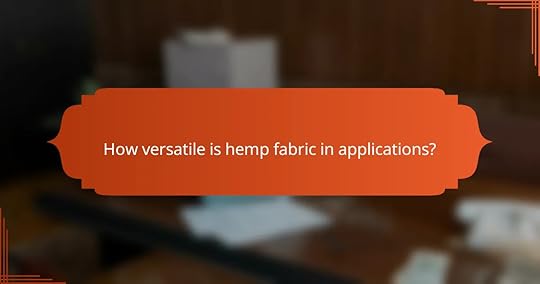
Hemp fabric is highly versatile, finding use in various applications due to its durability, breathability, and eco-friendliness. From clothing to industrial materials, hemp’s unique properties make it suitable for a wide range of products.
Clothing and apparelHemp fabric is increasingly popular in the clothing industry for its strength and breathability. It is often blended with other fibers, such as cotton or lyocell, to enhance comfort and durability. Hemp clothing is known for its natural UV resistance and moisture-wicking properties, making it ideal for activewear and summer garments.
When considering hemp for apparel, look for garments that are labeled as organic to ensure they are free from harmful pesticides. Additionally, hemp’s natural fibers tend to soften with each wash, improving comfort over time.
Home textilesIn home textiles, hemp fabric is used for items like curtains, upholstery, and bedding. Its breathability and hypoallergenic properties make it a great choice for sensitive individuals. Hemp textiles are also resistant to mold and mildew, which is beneficial in humid environments.
For home applications, consider hemp blends for added softness and versatility. Look for products certified by recognized standards, such as Global Organic Textile Standard (GOTS), to ensure sustainability and quality.
Industrial usesHemp fabric is utilized in various industrial applications, including ropes, nets, and biodegradable composites. Its strength and resistance to wear make it suitable for heavy-duty uses, such as in construction and automotive industries. Hemp’s low environmental impact also appeals to companies aiming for sustainable practices.
When exploring industrial hemp products, consider the specific requirements of your project, such as tensile strength and environmental conditions. Additionally, check for compliance with industry standards to ensure safety and performance.

Some of the best brands for hemp fabric products include Patagonia, Hemp Fortex, and Recreator. These companies are recognized for their commitment to sustainability, quality, and innovative designs in hemp textiles.
PatagoniaPatagonia is a leader in sustainable fashion, offering a range of hemp fabric products that emphasize environmental responsibility. Their hemp clothing is often blended with organic cotton or recycled materials, enhancing durability while maintaining breathability.
When choosing Patagonia, consider their commitment to fair labor practices and transparency in sourcing. Their products typically range from casual wear to outdoor gear, making them versatile for various activities.
Hemp FortexHemp Fortex specializes in high-quality hemp textiles, providing a wide array of fabrics suitable for fashion and home decor. They focus on eco-friendly production methods, ensuring that their hemp is sourced sustainably and processed with minimal environmental impact.
For those looking to purchase from Hemp Fortex, it’s important to note their offerings include both raw fabrics and finished garments. This flexibility allows designers and consumers to choose according to their specific needs, whether for clothing or upholstery.
RecreatorRecreator is known for its stylish and functional hemp apparel, emphasizing comfort and versatility. Their products are designed for active lifestyles, often featuring moisture-wicking properties and breathability, making them ideal for outdoor activities.
When selecting Recreator items, look for their unique designs that incorporate hemp with other sustainable materials. This brand is particularly appealing to those who value both fashion and environmental consciousness in their clothing choices.

Hemp fabric is generally more sustainable and durable than cotton, making it a strong alternative for eco-conscious consumers. While cotton is widely used, hemp offers superior breathability and requires less water and pesticides during cultivation.
Environmental impactHemp cultivation has a significantly lower environmental impact compared to cotton. It requires less water���often around half as much���and grows quickly, allowing for multiple harvests in a year. Additionally, hemp naturally suppresses weeds, reducing the need for chemical herbicides.
Moreover, hemp fabric is biodegradable, contributing to less waste in landfills. In contrast, conventional cotton farming often relies on harmful pesticides and fertilizers, which can lead to soil degradation and water pollution.
Durability and lifespanHemp fabric is known for its exceptional durability, often lasting three times longer than cotton. This resilience makes it ideal for products that undergo frequent use, such as clothing and upholstery. Hemp fibers are strong and resistant to wear, which translates to a longer lifespan for hemp-based products.
In practical terms, this means that while hemp items may have a higher upfront cost, their longevity can lead to savings over time as they do not need to be replaced as frequently as cotton items.
Cost-effectivenessWhile hemp fabric can be more expensive than cotton initially, its durability can make it more cost-effective in the long run. The price of hemp fabric typically ranges from moderate to high, depending on the quality and processing methods used.
Consumers should consider the total cost of ownership, factoring in the lifespan and maintenance of hemp products. Investing in hemp can be a wise choice for those looking for sustainable and long-lasting alternatives to cotton.

Caring for hemp fabric is straightforward and helps maintain its durability and appearance. Proper washing and drying techniques will ensure the longevity of your hemp items while preserving their natural qualities.
Washing recommendationsWhen washing hemp fabric, use cold or lukewarm water to prevent shrinkage and fading. A gentle cycle is preferable, along with mild detergent to avoid harsh chemicals that could damage the fibers.
It���s advisable to wash hemp items separately or with similar colors to prevent dye transfer. For heavily soiled items, consider soaking them in water with a small amount of detergent before washing.
Always check the care label for specific instructions, as some hemp blends may have different requirements. Avoid bleach, as it can weaken the fibers and alter the fabric’s color.
October 23, 2025
Gender-Neutral Sustainable Fashion: Inclusivity, Style and Choices
Gender-neutral sustainable fashion is revolutionizing the way we think about clothing by prioritizing inclusivity and eco-friendly practices. Brands like Patagonia, Everlane, and Reformation are leading the charge, offering stylish options that cater to diverse gender identities while minimizing environmental impact. By choosing versatile designs made from ethical materials, consumers can express their individuality and commitment to sustainability.
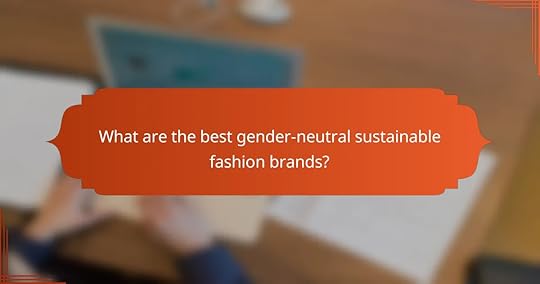
Some of the best gender-neutral sustainable fashion brands include Patagonia, Everlane, Reformation, ASOS, and Uniqlo. These brands prioritize inclusivity and eco-friendly practices, offering stylish options that cater to diverse gender identities.
PatagoniaPatagonia is renowned for its commitment to environmental sustainability and ethical manufacturing. The brand offers a range of gender-neutral clothing, including jackets, fleeces, and activewear, made from recycled materials and organic cotton.
When shopping at Patagonia, look for their Fair Trade Certified products, which ensure fair wages and safe working conditions for workers. Their repair and recycling programs also encourage customers to extend the life of their clothing.
EverlaneEverlane focuses on transparency in its supply chain, providing customers with detailed information about the production process. Their gender-neutral collection features minimalist designs that are versatile and timeless, suitable for various occasions.
The brand emphasizes ethical sourcing, with a commitment to using sustainable materials like TENCEL and recycled polyester. Everlane���s pricing model reflects the true cost of production, allowing consumers to make informed choices.
ReformationReformation is a leader in sustainable fashion, offering a wide range of stylish, gender-neutral options. Their clothing is made from eco-friendly materials, and they prioritize low-impact production methods to reduce their carbon footprint.
Reformation also provides a comprehensive sustainability report, detailing their environmental impact and goals. Their trendy pieces often feature bold prints and colors, appealing to a wide audience while promoting inclusivity.
ASOSASOS has made significant strides in offering gender-neutral clothing through its dedicated unisex collection. The brand features a variety of styles, from casual wear to formal attire, catering to diverse fashion preferences.
ASOS is committed to sustainability, with initiatives aimed at reducing waste and promoting ethical manufacturing. Their use of recycled materials and focus on eco-friendly practices make them a popular choice for conscious consumers.
UniqloUniqlo offers a range of gender-neutral basics that emphasize comfort and functionality. Their clothing is designed to be versatile, making it easy to mix and match for various styles and occasions.
The brand is known for its commitment to affordability and quality, with many items made from sustainable materials. Uniqlo’s focus on simplicity and practicality appeals to a broad audience, making sustainable fashion accessible to all.
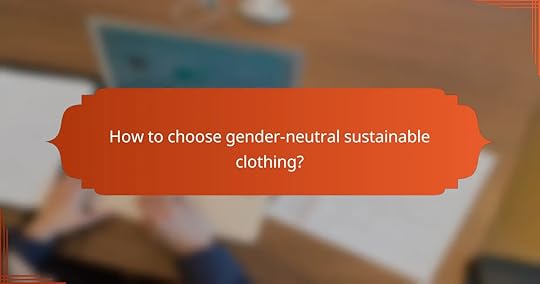
Choosing gender-neutral sustainable clothing involves selecting items that prioritize eco-friendly materials, ethical production practices, and versatile designs that suit all body types. Focus on brands that align with these values to make informed choices that reflect your commitment to sustainability and inclusivity.
Consider fabric sustainabilityWhen selecting gender-neutral sustainable clothing, prioritize fabrics that are eco-friendly and have a lower environmental impact. Look for materials such as organic cotton, Tencel, hemp, and recycled polyester, which are often produced with less water and fewer chemicals.
Additionally, consider the durability of the fabric. High-quality materials may have a higher upfront cost but can save money over time due to their longevity. Check for certifications like Global Organic Textile Standard (GOTS) or OEKO-TEX, which indicate sustainable practices.
Evaluate brand ethicsResearch the brands you are considering to ensure they adhere to ethical labor practices and sustainability standards. Look for transparency in their supply chains, fair wages for workers, and commitments to reducing carbon footprints.
Brands that participate in initiatives like the Ethical Trading Initiative or have B Corp certification often prioritize social and environmental responsibility. Avoid brands that lack transparency or have a history of unethical practices.
Assess fit and comfortFit and comfort are crucial when choosing gender-neutral clothing. Look for styles that offer flexibility in sizing, such as oversized or adjustable designs, which can accommodate various body shapes and preferences.
Pay attention to the cut and silhouette of the garments. Items with a relaxed fit or unisex styles often provide greater comfort and versatility. Always check size guides and consider trying on items when possible to ensure a good fit.
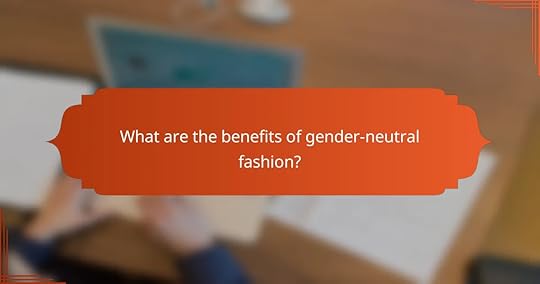
Gender-neutral fashion offers numerous advantages, including fostering inclusivity, minimizing environmental impact, and allowing for greater personal expression. By breaking traditional gender norms, this style promotes a more diverse and accepting approach to clothing choices.
Promotes inclusivityGender-neutral fashion creates a welcoming environment for individuals of all gender identities. It eliminates the constraints of traditional gendered clothing, allowing everyone to find styles that resonate with their personal identity.
This inclusivity can be particularly beneficial in retail settings, where a diverse range of options can attract a broader customer base. Brands that embrace gender-neutral designs often see increased loyalty from consumers who value representation and acceptance.
Reduces wasteGender-neutral fashion contributes to sustainability by reducing waste associated with overproduction and discarded clothing. When clothing is designed to be worn by anyone, it encourages longer-lasting use and reduces the need for separate collections for different genders.
Additionally, consumers are more likely to invest in versatile pieces that can be styled in multiple ways, leading to fewer purchases overall. This shift can significantly decrease the environmental footprint of the fashion industry.
Encourages personal expressionWith gender-neutral fashion, individuals can express themselves without the limitations of traditional gender categories. This freedom allows for a more authentic representation of personal style, encouraging creativity and individuality.
Shoppers can mix and match items from various collections, creating unique outfits that reflect their personality. This approach not only enhances self-expression but also promotes a more dynamic and fluid understanding of fashion as a whole.
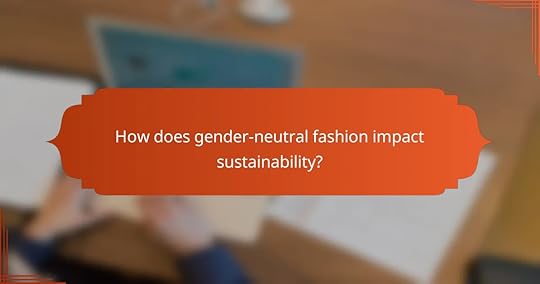
Gender-neutral fashion significantly enhances sustainability by reducing waste and promoting inclusivity in clothing choices. By focusing on versatile designs that appeal to all genders, brands can minimize overproduction and encourage more sustainable consumption patterns.
Minimizes overproductionGender-neutral fashion minimizes overproduction by creating versatile pieces that can be worn by anyone, regardless of gender. This approach reduces the need for separate lines targeting specific demographics, leading to fewer items produced overall.
For example, a single unisex jacket can serve multiple customer segments, decreasing the total quantity of clothing made. Brands can also adopt a made-to-order model, producing items only when there is demand, which further curtails excess inventory.
Supports circular economyGender-neutral fashion supports a circular economy by encouraging the reuse and recycling of garments. When clothing is designed to appeal to a broader audience, it increases the likelihood that items will be passed on or resold, extending their lifecycle.
Brands can enhance this model by implementing take-back programs, where customers return old items for recycling or refurbishment. This not only reduces waste but also fosters a culture of sustainability among consumers, making them more conscious of their fashion choices.

Gender-neutral sustainable fashion is increasingly characterized by inclusivity, eco-friendly materials, and innovative design approaches. Key trends include the rise of upcycled materials and the growth of rental services, both of which promote sustainability while catering to diverse styles.
Rise of upcycled materialsThe use of upcycled materials in gender-neutral sustainable fashion is gaining traction as brands seek to reduce waste and minimize their environmental impact. Upcycling involves repurposing discarded textiles and garments into new, stylish pieces, which helps divert waste from landfills.
Many designers are creatively transforming old clothing into unique items, such as jackets made from vintage denim or bags crafted from surplus fabric. This trend not only promotes sustainability but also offers consumers one-of-a-kind fashion choices that reflect personal style.
Growth of rental servicesRental services for clothing are becoming a popular option in the gender-neutral sustainable fashion landscape. These services allow individuals to rent garments for special occasions or everyday wear, reducing the need for fast fashion purchases and encouraging a more sustainable wardrobe.
Many platforms offer a diverse range of styles that cater to all genders, making it easy to find pieces that suit individual tastes. Renting can be a cost-effective alternative, with prices typically ranging from a few dollars to several hundred, depending on the item and rental duration.
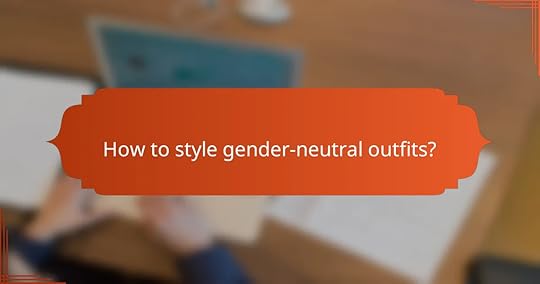
Styling gender-neutral outfits involves blending elements that appeal to all genders while prioritizing comfort and personal expression. Focus on versatile pieces that can be mixed and matched, allowing for a unique style that reflects individuality.
Layering techniquesLayering is a key technique in creating gender-neutral outfits, as it adds depth and versatility. Start with a base layer, such as a fitted t-shirt or tank top, and build your look with additional layers like oversized shirts, cardigans, or lightweight jackets.
Consider the balance of proportions when layering. For instance, pairing a long, loose outer layer with a more fitted bottom can create a flattering silhouette. Neutral colors often work well together, but don’t hesitate to mix in bold patterns or colors to express your style.
When layering, choose fabrics that complement each other for comfort and movement. Lightweight materials like cotton or linen are great for warmer weather, while thicker fabrics like wool or fleece can provide warmth in cooler climates. Aim for a mix of textures to enhance visual interest without overwhelming the outfit.
October 21, 2025
Sustainable Clothing Brands: Top Picks for Conscious Consumers
As the demand for eco-friendly fashion grows, several sustainable clothing brands are leading the way with their commitment to ethical production and environmentally responsible materials. These brands not only offer stylish options for conscious consumers but also emphasize transparency and fair labor practices, making it easier to make informed choices that align with personal values.
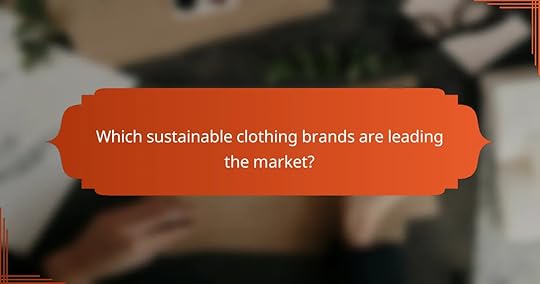
Several sustainable clothing brands are at the forefront of the market, focusing on eco-friendly materials, ethical production practices, and transparency. These brands not only prioritize environmental responsibility but also cater to conscious consumers seeking stylish and sustainable options.
PatagoniaPatagonia is renowned for its commitment to environmental activism and sustainable practices. The brand uses organic cotton, recycled materials, and offers a repair program to extend the life of its products. Their dedication to transparency includes detailed information about their supply chain and environmental impact.
When choosing Patagonia, consider their wide range of outdoor apparel, which is designed for durability and performance. Look for their Fair Trade Certified options, which ensure fair labor practices in production.
Eileen FisherEileen Fisher focuses on timeless designs and sustainable materials, including organic and recycled fibers. The brand emphasizes ethical manufacturing processes and has a take-back program to recycle old garments, promoting a circular economy.
For consumers, Eileen Fisher offers a selection of versatile pieces that can be mixed and matched. Their commitment to size inclusivity and fair wages makes them a strong choice for conscious shoppers.
ReformationReformation is a trendy brand that combines style with sustainability, using eco-friendly materials and practices. They track their environmental impact and provide transparency through their “RefScale,” which shows the sustainability of each item.
When shopping at Reformation, look for their collections that feature limited-edition styles, which often sell out quickly. Their commitment to reducing waste and carbon emissions makes them a popular choice among younger consumers.
EverlaneEverlane is known for its “Radical Transparency” policy, revealing the true costs behind each product. The brand uses sustainable materials and ethical factories, ensuring fair wages and safe working conditions for workers.
Consumers can benefit from Everlane’s focus on essentials, offering high-quality basics that are designed to last. Their pricing is competitive, making sustainable fashion accessible without sacrificing style.
People TreePeople Tree is a pioneer in sustainable and fair trade fashion, focusing on organic materials and ethical production. The brand collaborates with artisans and farmers to create unique, handcrafted pieces that support local communities.
When considering People Tree, look for their certifications, such as GOTS (Global Organic Textile Standard), which ensures high environmental and social standards. Their collections often feature bold prints and styles that stand out while promoting sustainability.
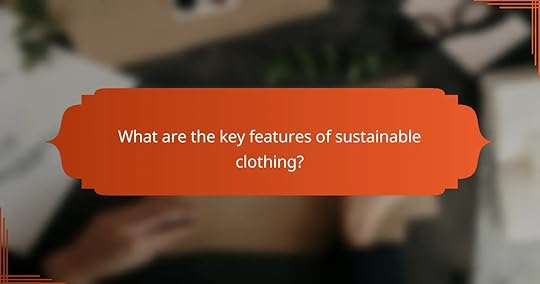
Sustainable clothing is characterized by eco-friendly materials, ethical labor practices, and durability. These features ensure that garments are produced with minimal environmental impact and promote fair treatment of workers.
Eco-friendly materialsEco-friendly materials are those sourced from renewable resources or recycled content, reducing the demand for virgin materials. Common examples include organic cotton, Tencel, and recycled polyester. When shopping, look for certifications like Global Organic Textile Standard (GOTS) or OEKO-TEX, which indicate environmentally responsible production processes.
Choosing clothing made from these materials can significantly lower your carbon footprint. Additionally, consider the lifecycle of the fabric; biodegradable options can minimize landfill waste when the garment is discarded.
Ethical labor practicesEthical labor practices ensure that workers involved in the clothing production process are treated fairly and compensated adequately. Brands that prioritize these practices often provide safe working conditions, reasonable hours, and a living wage. Look for brands that are transparent about their supply chains and have certifications such as Fair Trade.
Supporting companies that adhere to ethical labor standards not only benefits workers but also aligns with the values of conscious consumers. Avoid brands that lack transparency or have been linked to labor exploitation.
Durability and longevityDurability and longevity are essential features of sustainable clothing, as they reduce the frequency of replacement and waste. High-quality garments made from robust materials can withstand wear and tear, extending their lifespan. When evaluating durability, consider the stitching, fabric weight, and overall construction of the item.
Investing in timeless, well-made pieces can save money in the long run and lessen environmental impact. Avoid fast fashion items that may be cheaper upfront but often wear out quickly, leading to more waste and consumption.
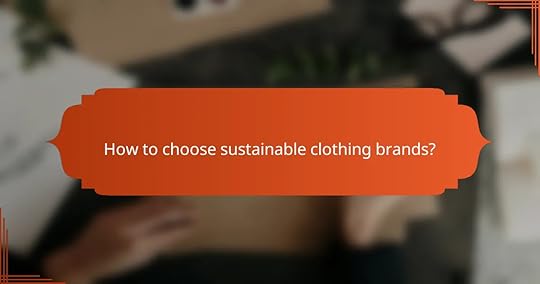
Choosing sustainable clothing brands involves assessing their environmental impact, ethical practices, and commitment to transparency. Focus on certifications, sourcing practices, and production locations to ensure your choices align with your values.
Research brand certificationsBrand certifications are essential indicators of a company’s commitment to sustainability. Look for certifications like Global Organic Textile Standard (GOTS), Fair Trade, and OEKO-TEX, which signify adherence to environmental and social standards.
These certifications often require brands to meet specific criteria regarding materials, labor practices, and environmental impact. Checking for these labels can help you identify brands that prioritize sustainability.
Evaluate transparency in sourcingTransparency in sourcing is crucial for understanding a brand’s supply chain and ethical practices. Brands that openly share information about where and how their materials are sourced demonstrate accountability and a commitment to sustainability.
Look for brands that provide detailed information on their websites about their sourcing practices, including the origin of materials and the conditions under which they are produced. This can help you make informed decisions about your purchases.
Consider local productionSupporting brands that produce locally can significantly reduce carbon footprints associated with transportation. Local production often means shorter supply chains and better oversight of labor practices.
When evaluating brands, consider those that manufacture within your country or region. This not only supports local economies but also often ensures higher standards of labor and environmental practices.

Buying sustainable clothing offers numerous advantages, including a reduced environmental footprint and support for ethical labor practices. These benefits not only contribute to a healthier planet but also promote fair treatment of workers in the fashion industry.
Reduced environmental impactSustainable clothing is designed to minimize harm to the environment. This includes using organic materials, reducing water consumption, and employing eco-friendly production methods. By choosing these options, consumers can help decrease pollution and waste associated with traditional fashion manufacturing.
For instance, brands that utilize recycled fabrics can significantly lower the amount of new resources needed, leading to less deforestation and energy use. Additionally, many sustainable brands focus on local production to reduce transportation emissions.
Support for ethical laborPurchasing sustainable clothing often means supporting brands that prioritize fair labor practices. These companies typically ensure that workers are paid fairly and work in safe conditions, adhering to ethical standards. This contrasts sharply with fast fashion, where labor exploitation is common.
Look for certifications such as Fair Trade or GOTS (Global Organic Textile Standard) when selecting brands. These labels indicate a commitment to ethical labor practices and can guide consumers in making responsible choices.
Long-term cost savingsInvesting in sustainable clothing can lead to long-term savings. While the initial purchase price may be higher, sustainable garments are often made to last longer than fast fashion items. This durability means fewer replacements over time, ultimately saving money.
Consider the cost-per-wear approach: a high-quality sustainable shirt worn hundreds of times may cost less in the long run than multiple cheaper shirts that wear out quickly. Additionally, many sustainable brands offer repair services, further extending the life of your clothing.
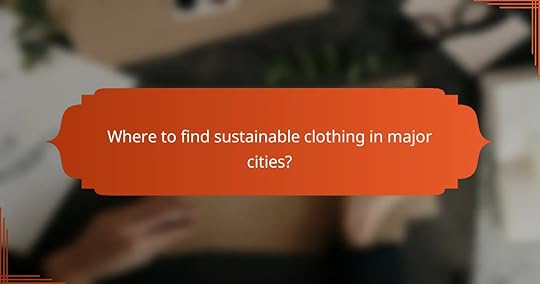
Major cities often have a variety of options for finding sustainable clothing, including dedicated eco-friendly boutiques, thrift shops, and larger retailers with sustainable lines. Exploring local markets and online platforms can also yield unique finds that align with conscious consumer values.
Eco-friendly boutiquesEco-friendly boutiques are a great starting point for sustainable clothing. These shops typically curate collections from brands that prioritize ethical production, organic materials, and fair labor practices. Look for boutiques that provide transparency about their sourcing and manufacturing processes.
In cities like New York, Los Angeles, and London, you can find numerous eco-conscious boutiques. For example, stores such as Reformation and Eileen Fisher offer stylish options while maintaining a commitment to sustainability.
Thrift and vintage shopsThrift and vintage shops are excellent places to discover sustainable clothing at lower prices. By purchasing second-hand items, you contribute to reducing waste and extending the lifecycle of garments. Many thrift stores also support local charities, adding a community benefit to your purchase.
In cities, you can often find well-stocked thrift shops in neighborhoods known for their eclectic style. Popular chains like Goodwill and Salvation Army, as well as local vintage shops, can provide a wide range of clothing options.
Online sustainable retailersOnline sustainable retailers have gained popularity, offering a convenient way to shop for eco-friendly clothing. Websites like Everlane, Patagonia, and ASOS’s Eco Edit feature a range of sustainable options, from casual wear to activewear. Many of these retailers provide detailed information about their sustainability practices.
When shopping online, look for certifications such as GOTS (Global Organic Textile Standard) or Fair Trade, which can help ensure that the clothing meets specific environmental and ethical standards.
Local markets and pop-up shopsLocal markets and pop-up shops often showcase independent designers and sustainable brands. These venues provide an opportunity to support local artisans while finding unique clothing items. Many markets focus on sustainability, featuring vendors who prioritize eco-friendly practices.
Check community boards or social media for upcoming markets in your area. Participating in these events can also connect you with like-minded individuals and provide insights into sustainable fashion trends.
September 9, 2014
6 Weeks…..
The next six weeks are (already) incredible & unbelievable for me. Let me tell you why.
Back in 2012, I wrote this post saying that I sold the book baby of my heart, FOLLOW ME THROUGH DARKNESS. To say it was exciting is an understatement.
Then, in 2013, I wrote this one because I’d sold SALT, the book I wrote while taking a break on my book baby. The publishers agreed that both SALT books should come out before FMTD, in an effort to help support the bigger trilogy and carry over a readership. This was a good decision, ultimately, but man, it’s been long. This whole year (really, my life since May 2013) has been spent in revisions: revisions for SALT, for FMTD, drafting STORM and book 2 in the trilogy while still editing the others, always, always, revising. 2014 has been a blur of revisions, and that’s fine. I’m immensely proud of the books that I’m putting out.
A year later, or nine months ago to be exact, SALT came out. Since then so many people have loved Pen’s story, and told me how enjoyable it was. (Obviously, some people don’t love it, too, but that’s totally part of the process, and I’m still grateful they read it. Not every book is for every person.)
In three weeks, STORM will be out for readers. (The advanced copies are already available!) AND you can add it on Goodreads.
And, in six weeks, FOLLOW ME THROUGH DARKNESS will join SALT and STORM in the world.
If you are keeping track, that means I’ve released three books in a single year. To go from nothing to THREE is mind-blowing for me. I remember the days I never thought I’d have one out there, and now three. (I will stop saying “three” now.)
Why are you saying all this, Danielle?
Since, over the next six weeks, I have two books coming out I’m probably going to tweet a lot about it. Not just because I want you to buy it (which I do, please), but because I’m completely thrilled. 
I can’t wait for people who loved SALT to finish out Pen and Carter’s story in STORM. I want them to know what happens next, and to hear their thoughts about it. I have so much joy in my heart for this series and its readers. (Plus, I hear it will be at a low price so you should not miss out.)
Even more, I’m beyond ready for FOLLOW ME THROUGH DARKNESS. I started writing that book in 2010. 2010! I sold it in 2012, and it’s coming out soon. It’s been a tremendous wait, but it’s six weeks away now! Author Beth Revis once shared this post about the “book of your heart” and how this is the “one that is ripped from your very soul. It’s the important one, your baby, the one that you wrote with blood, sweat, and tears; the one that means more to you than any other.” FOLLOW ME THROUGH DARKNESS is that book for me, at least in YA. It’s been such a part of my life and it consumes this large part of my heart, which is good since I still have the rest of the series to publish.
The one difference that I have is since it has been part of my heart for so long, I’m not scared of sharing it. I believe in it. I love my main character, Neely, and her story, the world she lives in, and the love she has for others. I know, like SALT, there will be readers who don’t get it or like it—but there will be readers who love it, connect with it and talk about it. I accepted a long time ago when trudging through the query trenches that this book wouldn’t be for everyone, but I sure hope that everyone tries to read it. Because, well, that’s why I wrote it…
As we get closer to release, I’m going to be organizing some giveaways, some teasers to share, and sharing two fantastic blurbs from authors that I adore. I can’t wait to get you as excited as I am. Additionally, if you want to help me out then you can sign up for my blog tour here; you can also join my street team via Facebook here or email by sending me an email, a tweet, or leaving your email in a comment.
In six weeks, FMTD won’t be just my heart anymore: it will be yours.
That is a terrific feeling.
I hope you think so, too.



